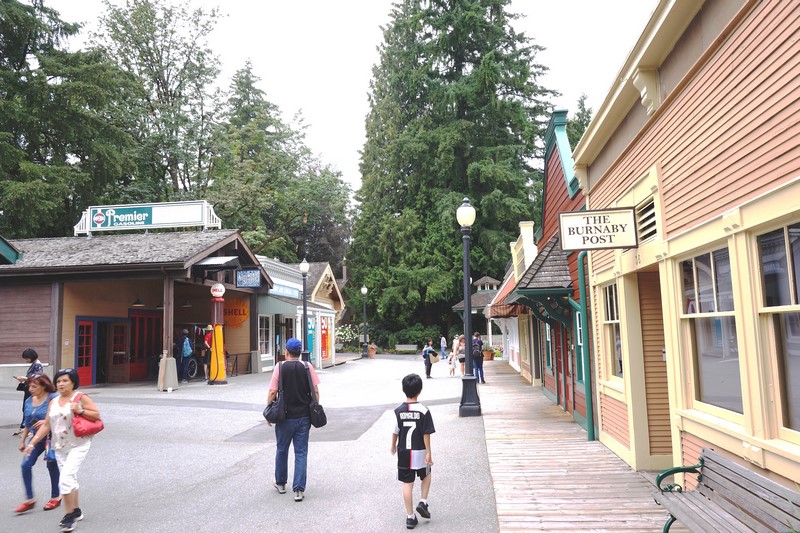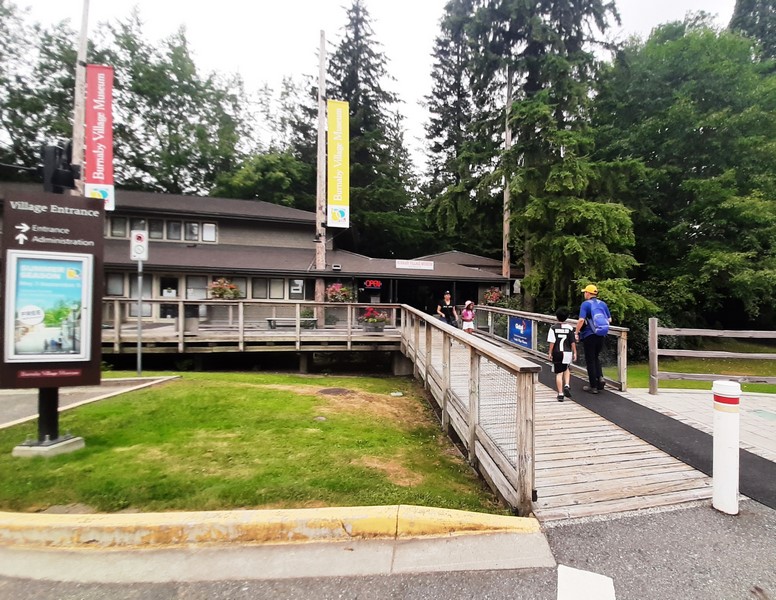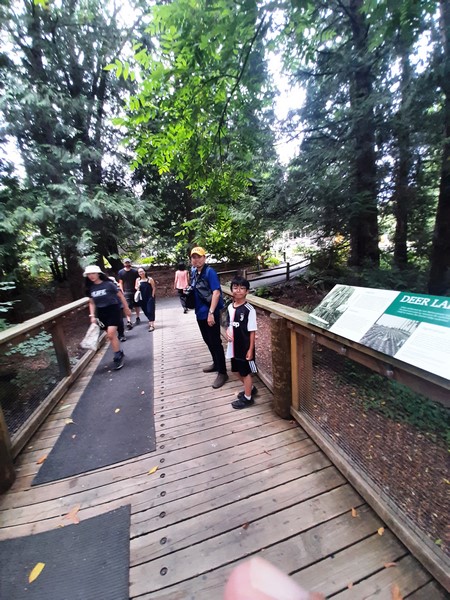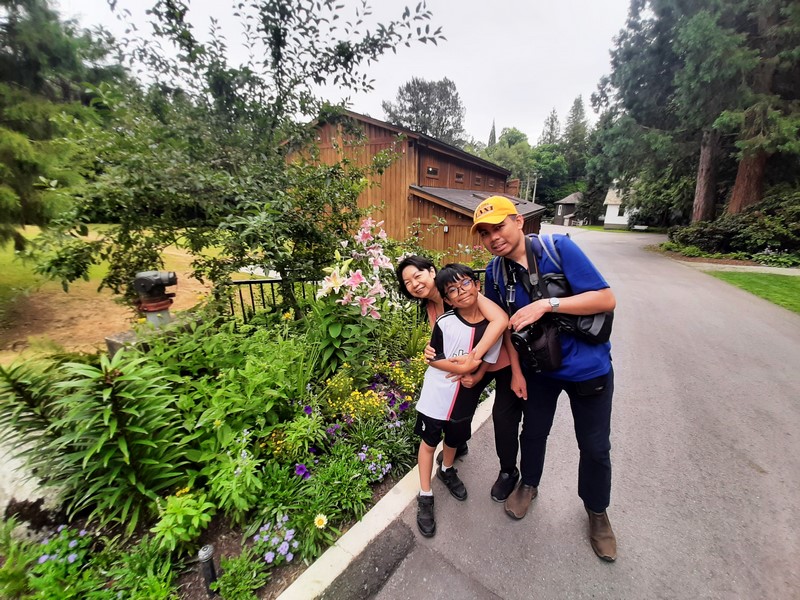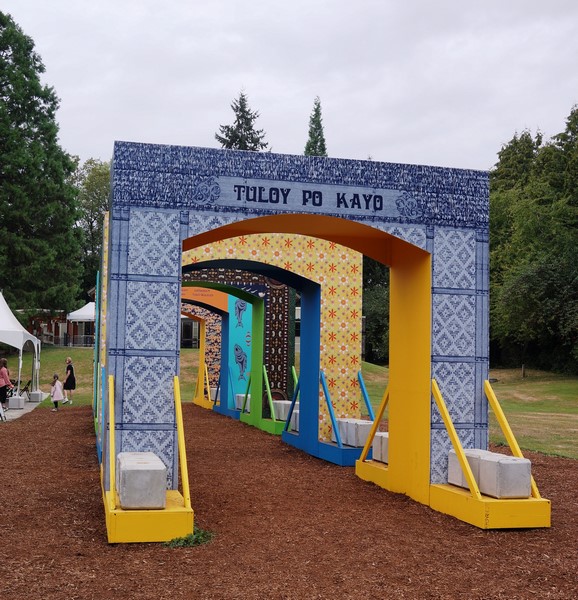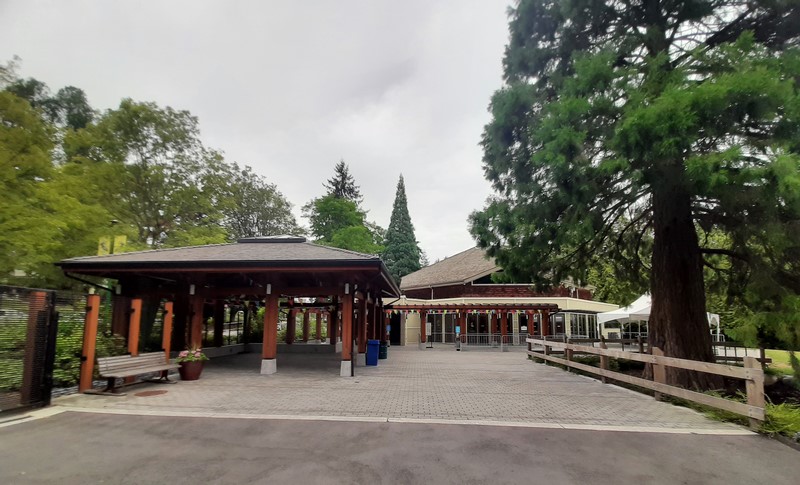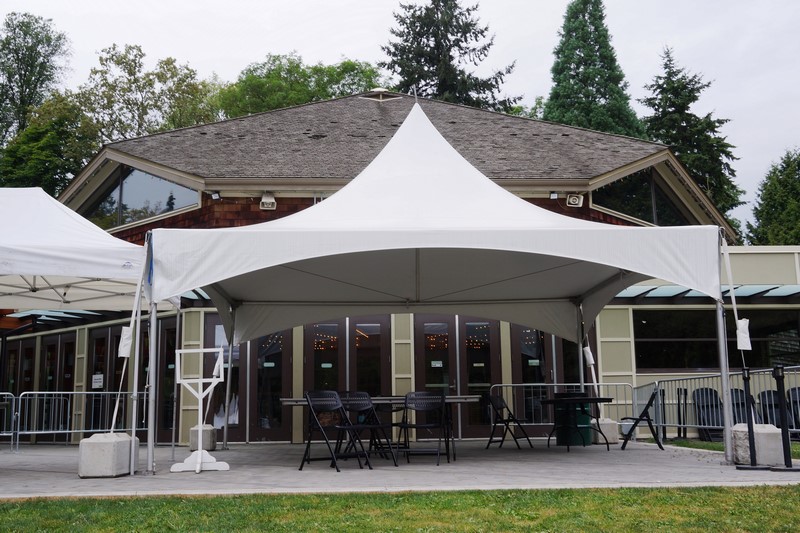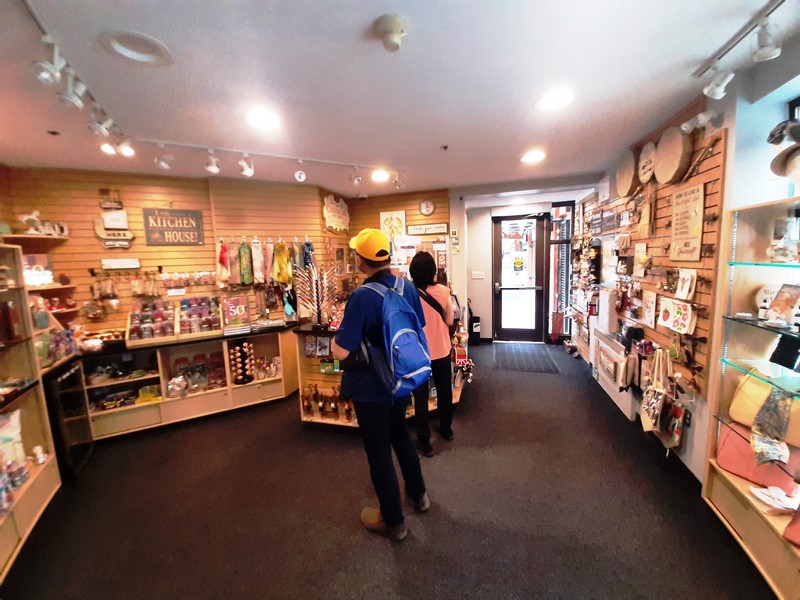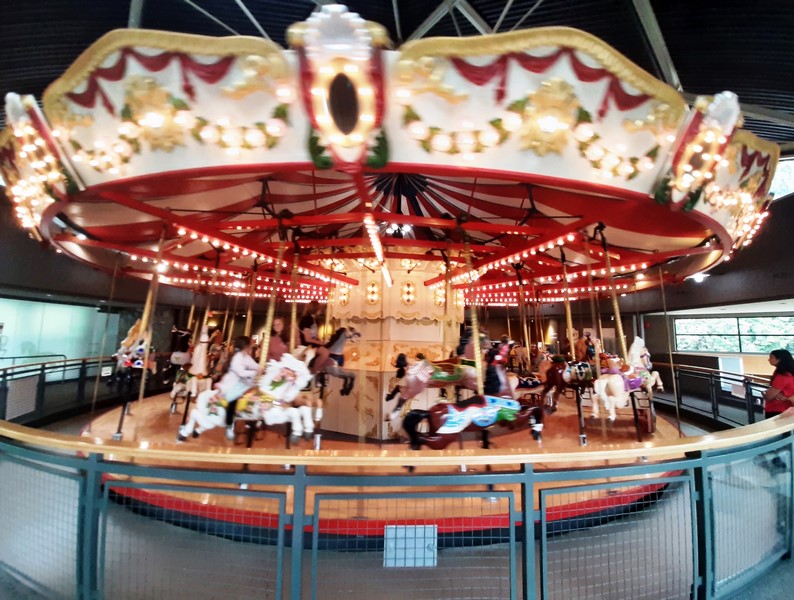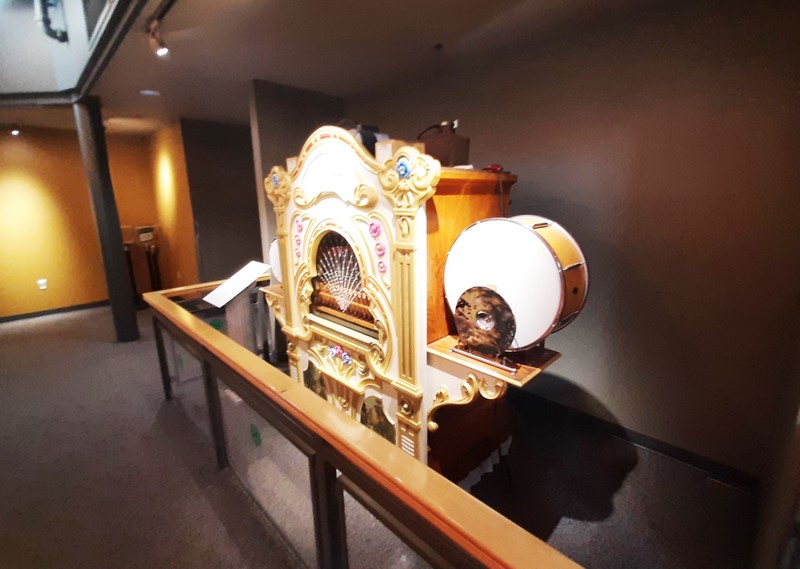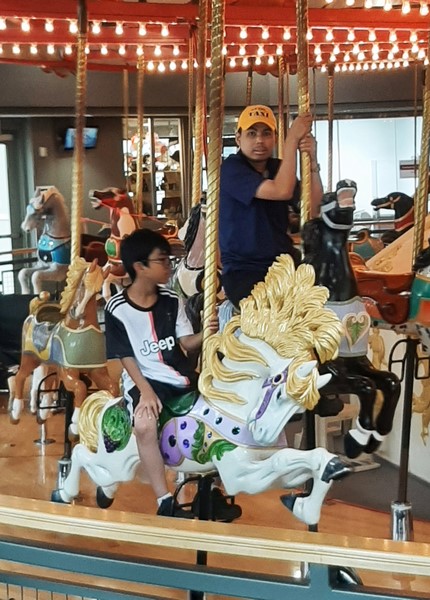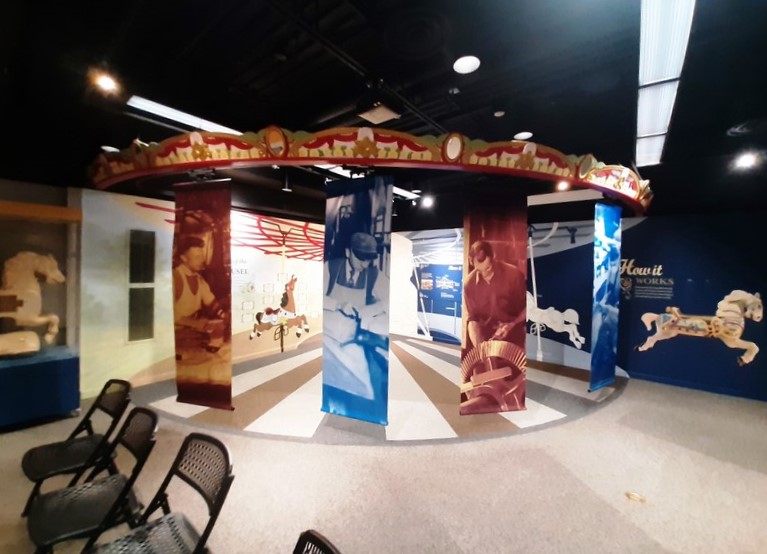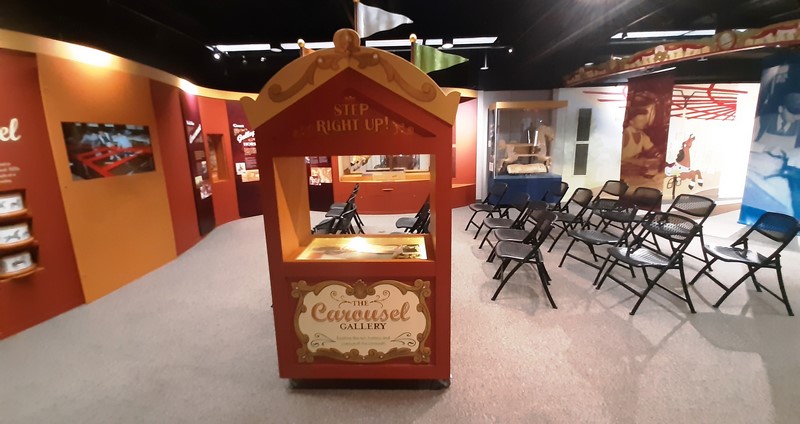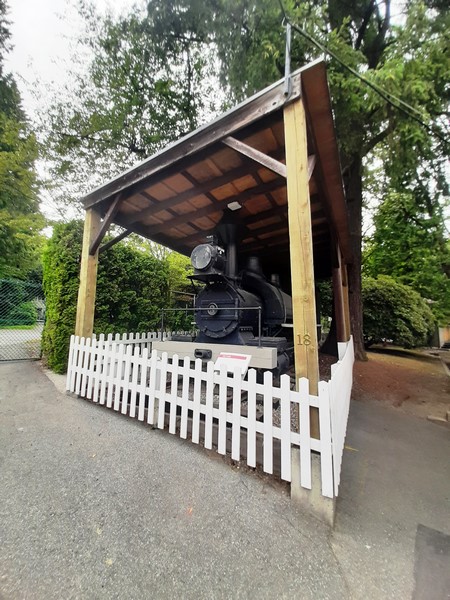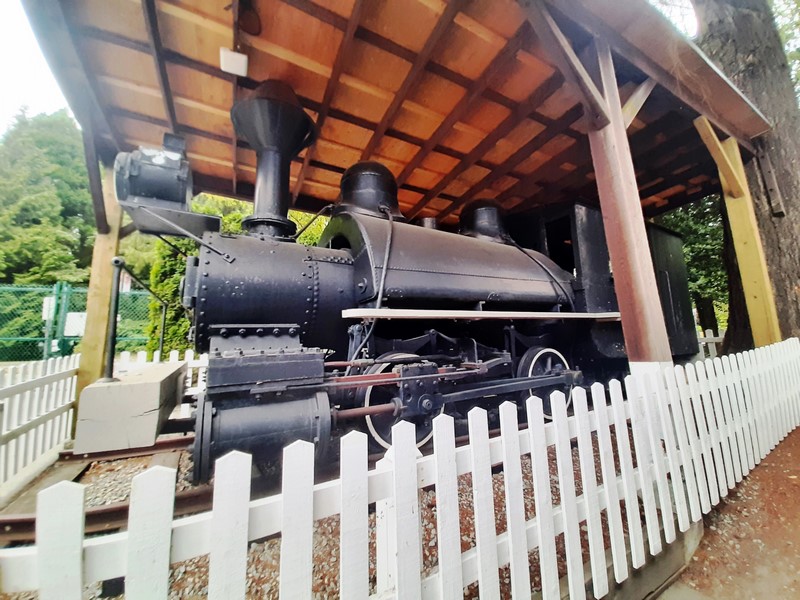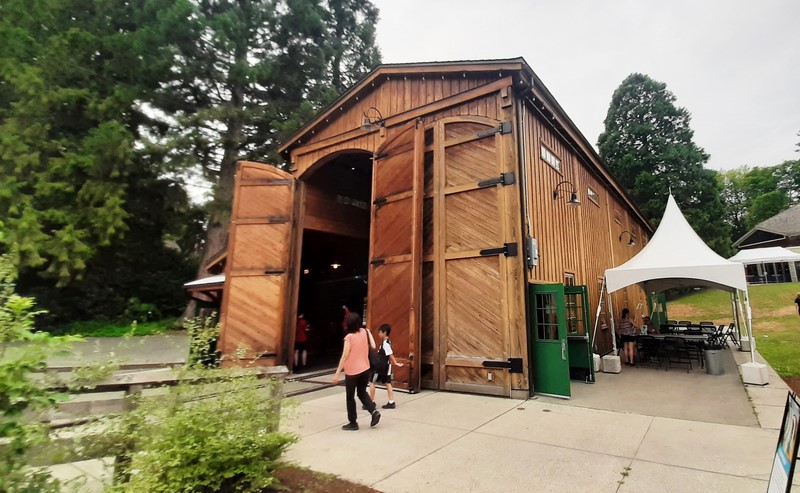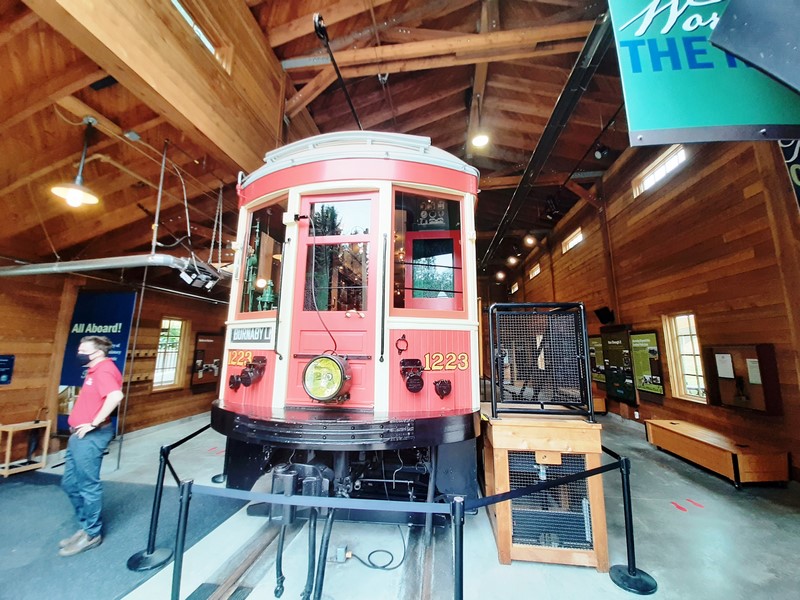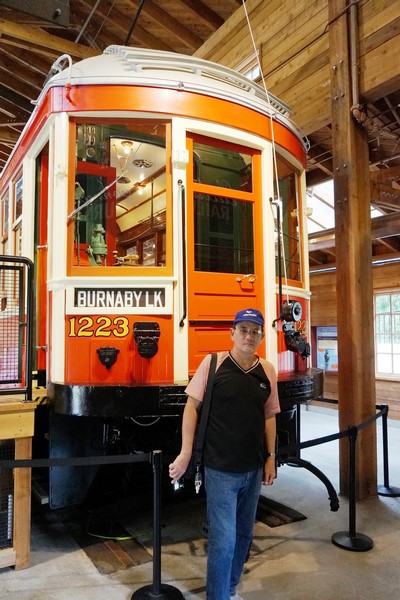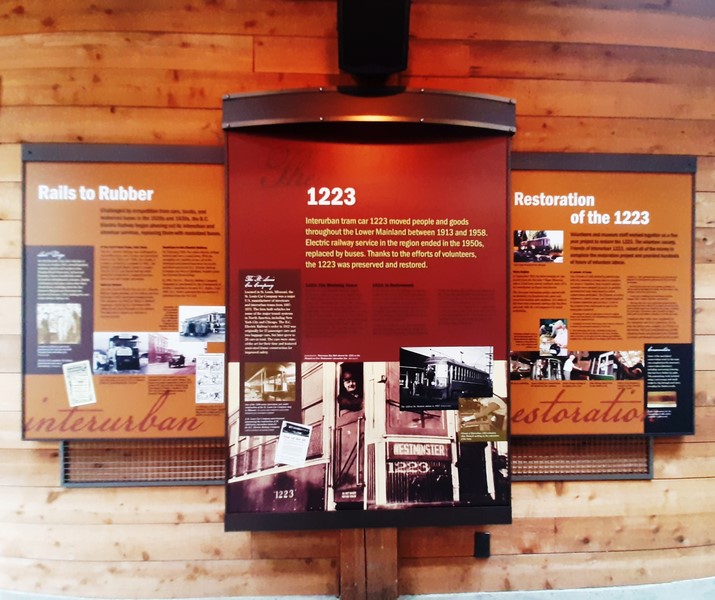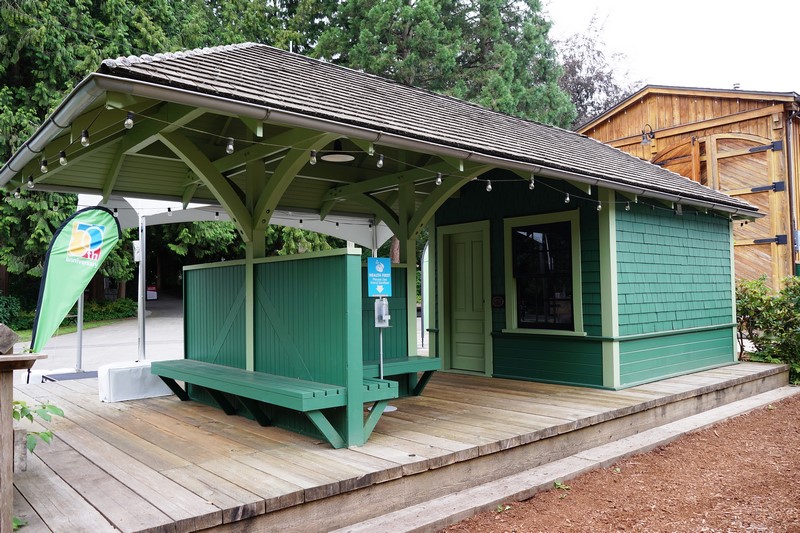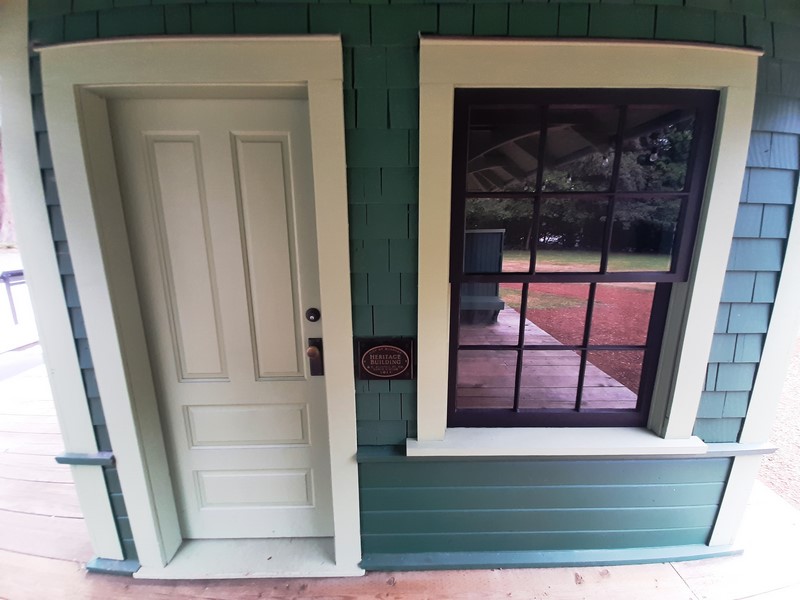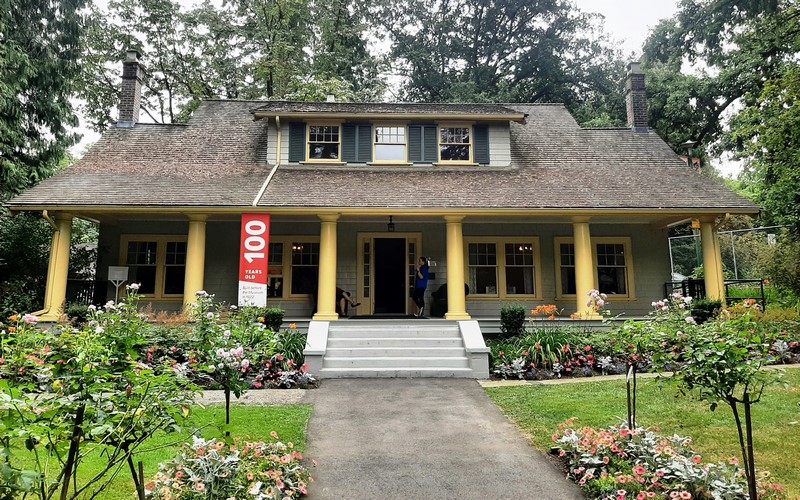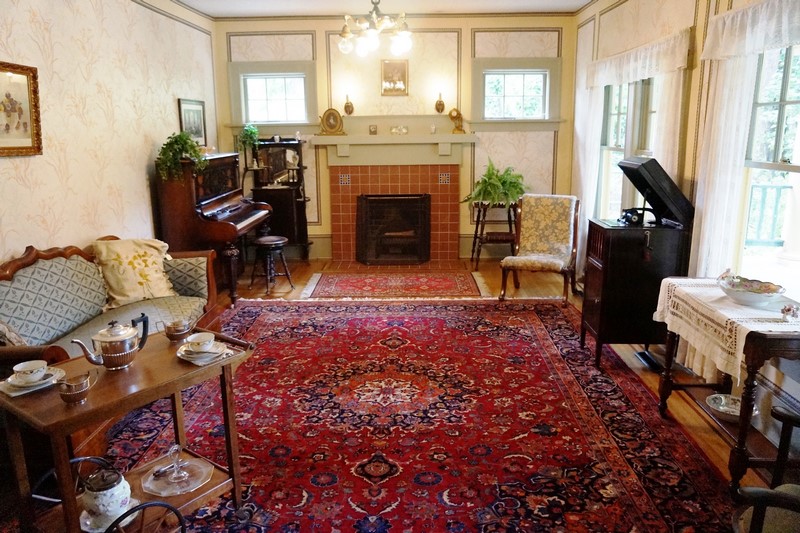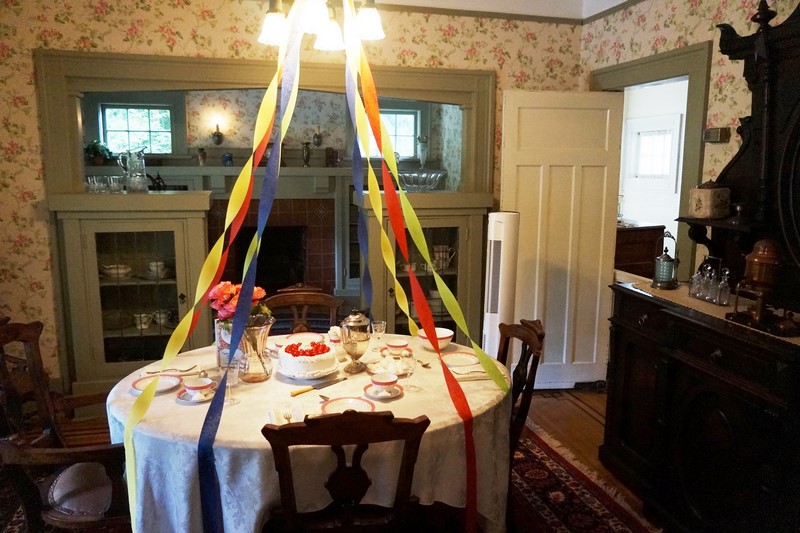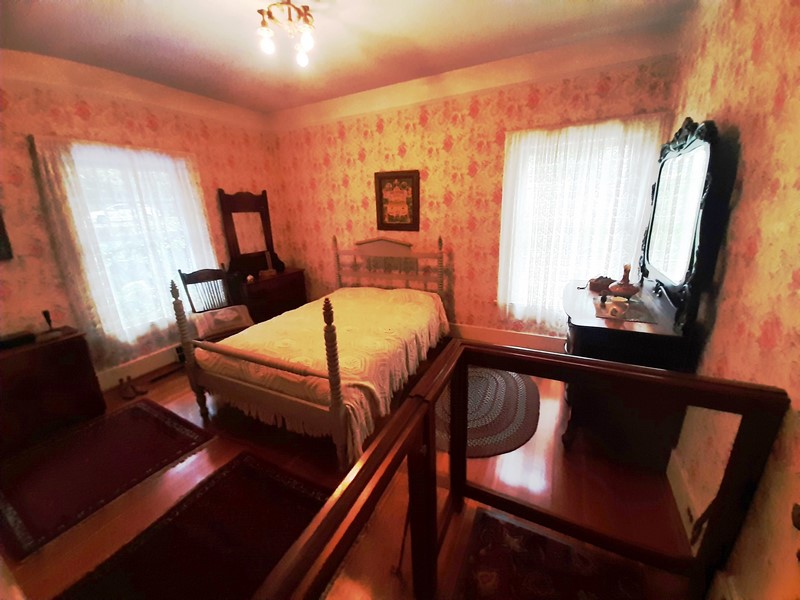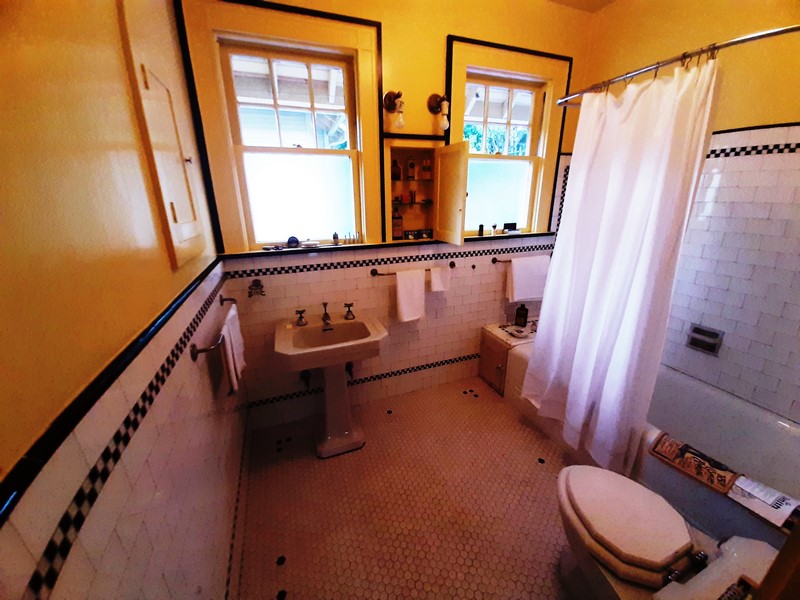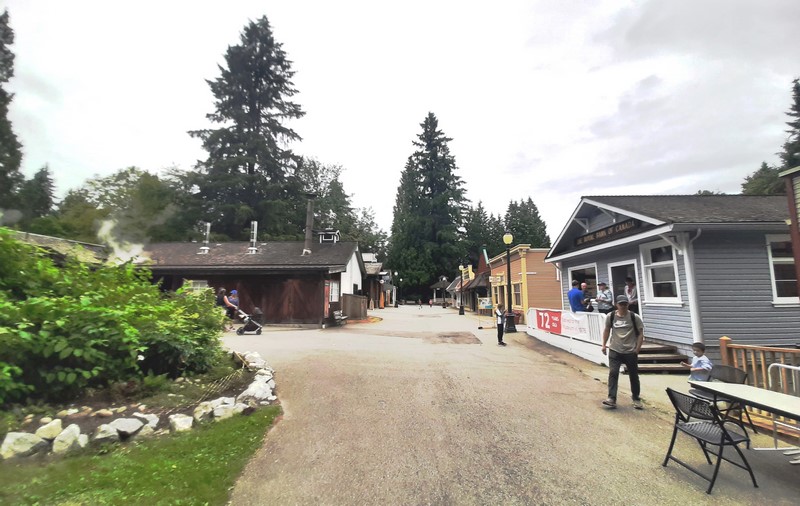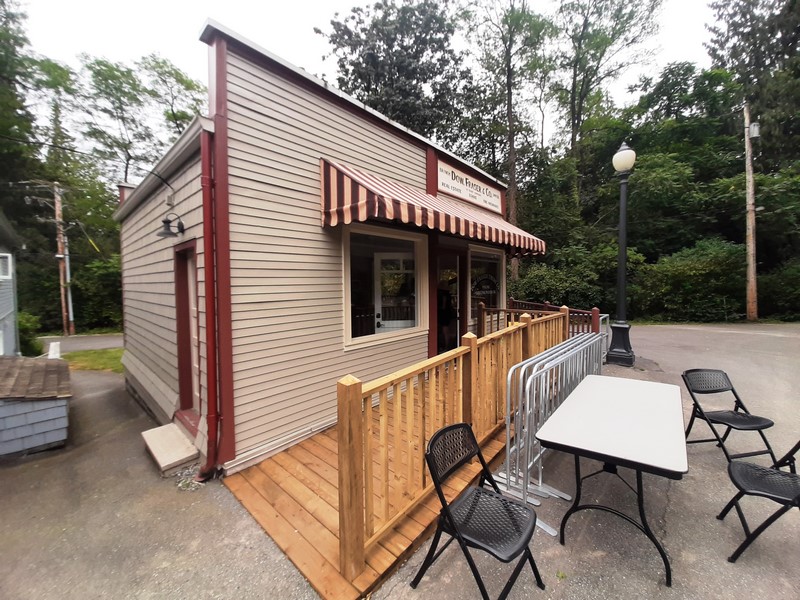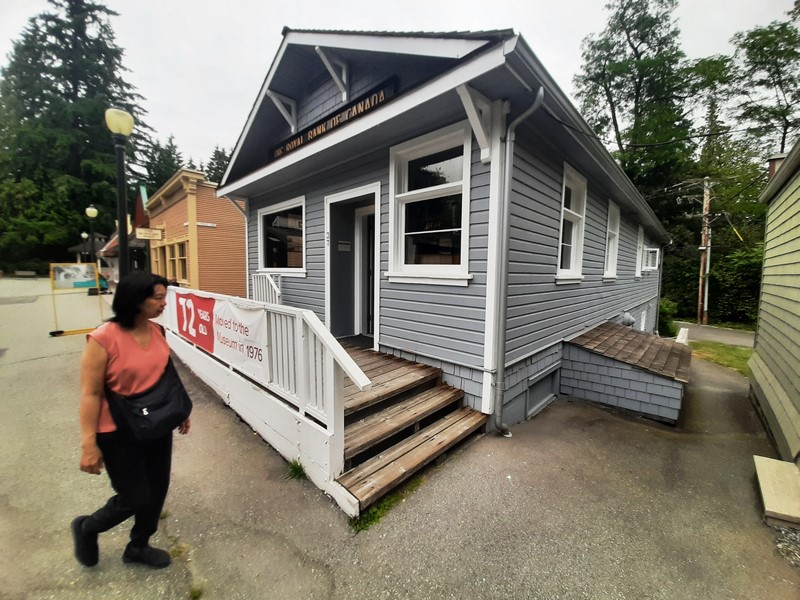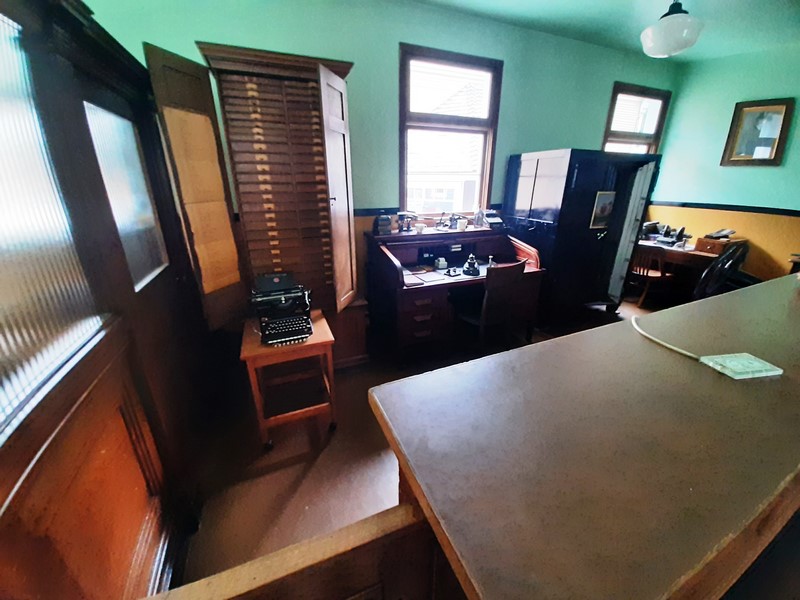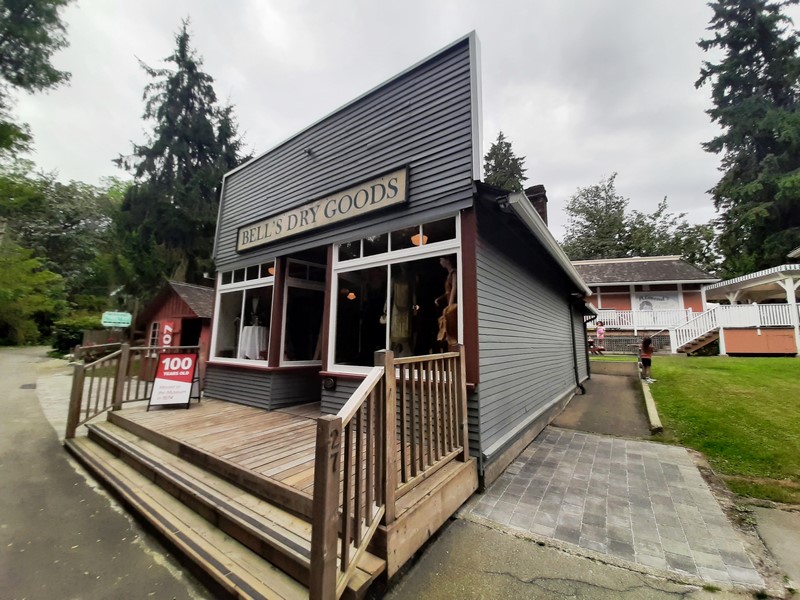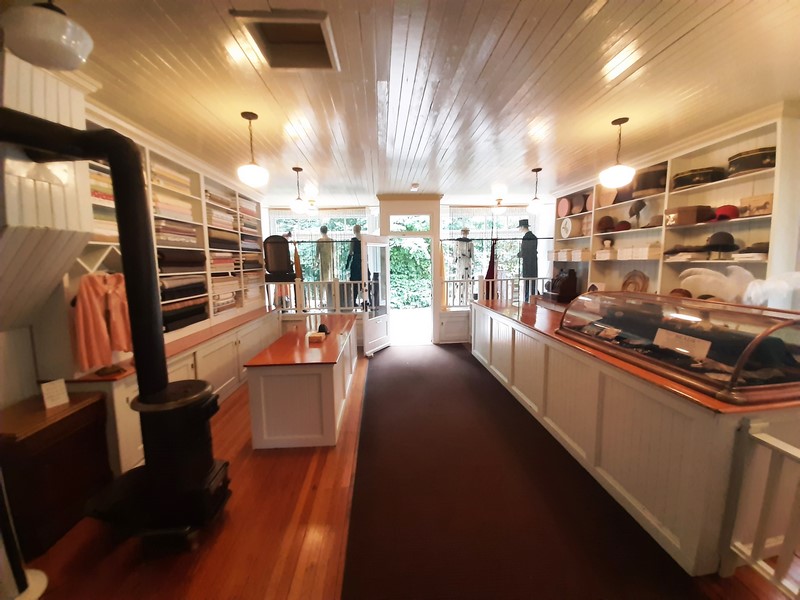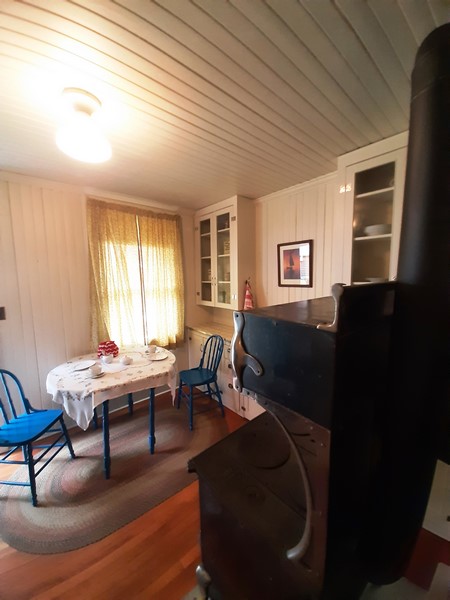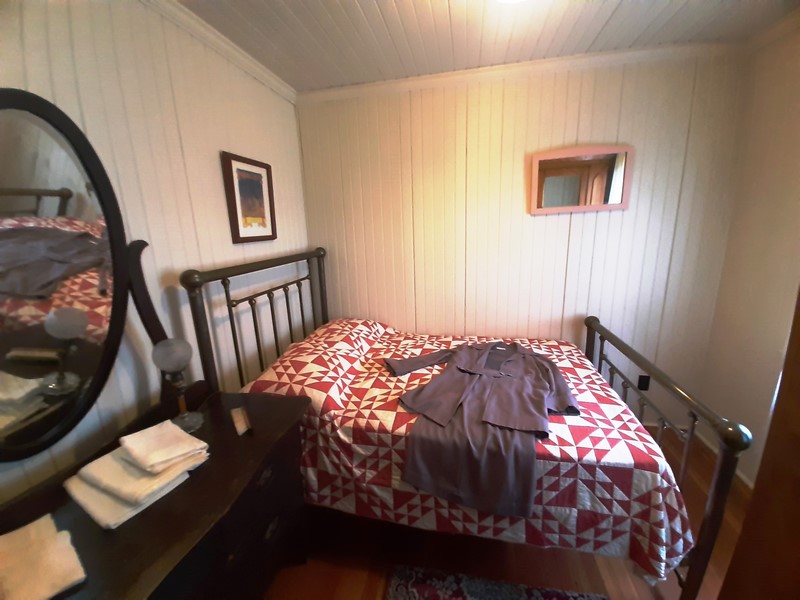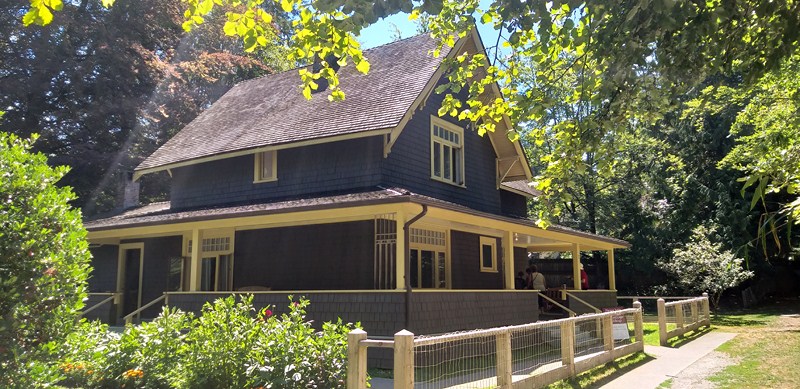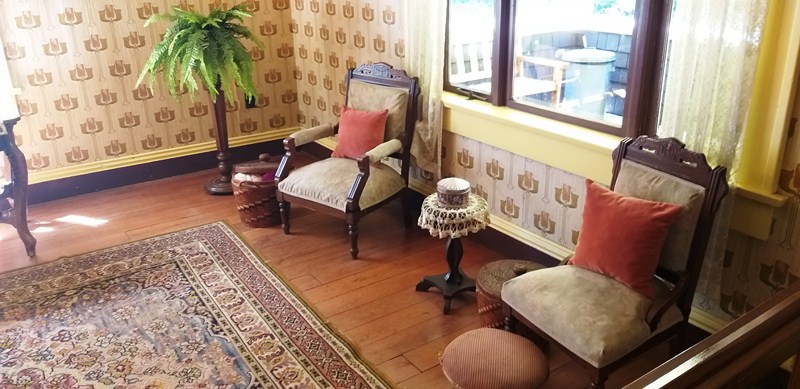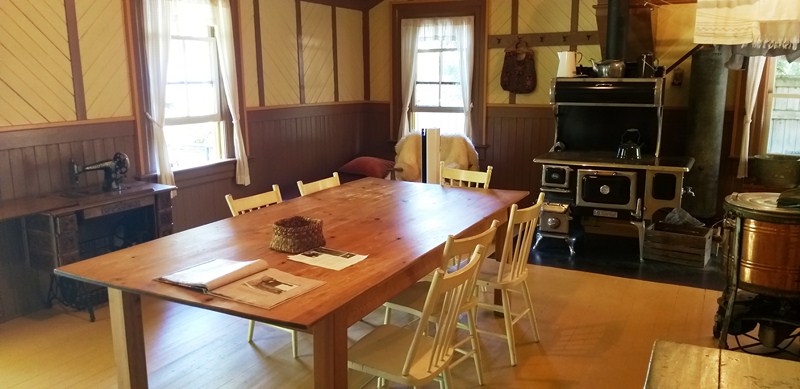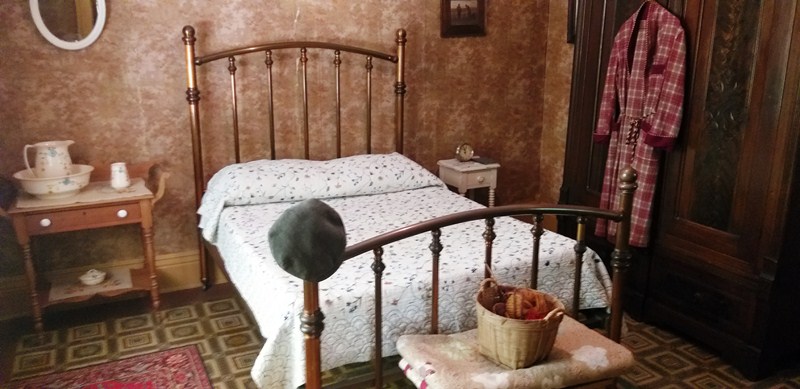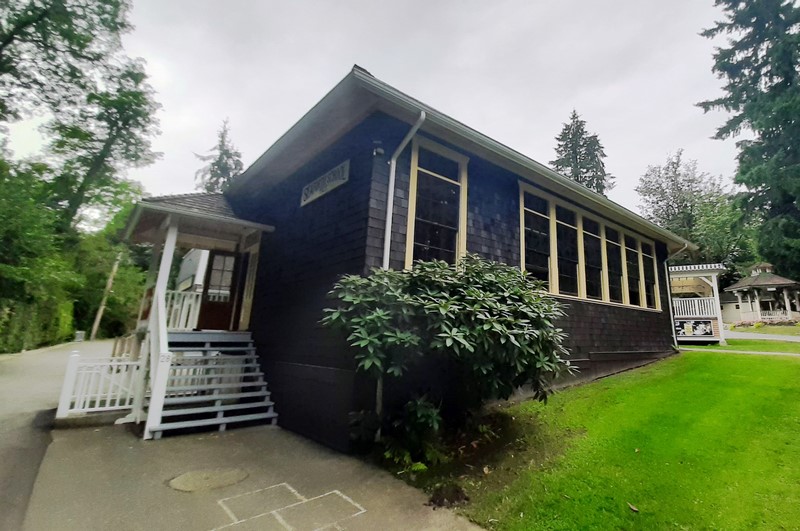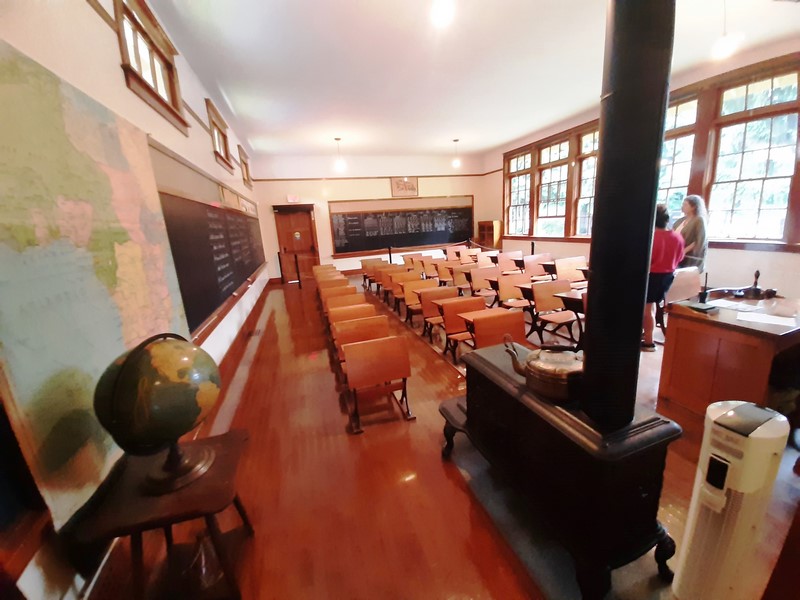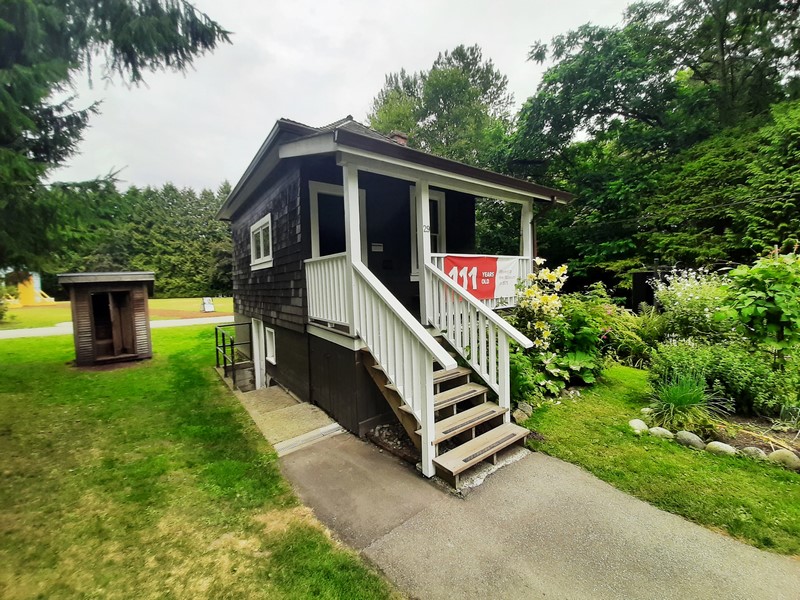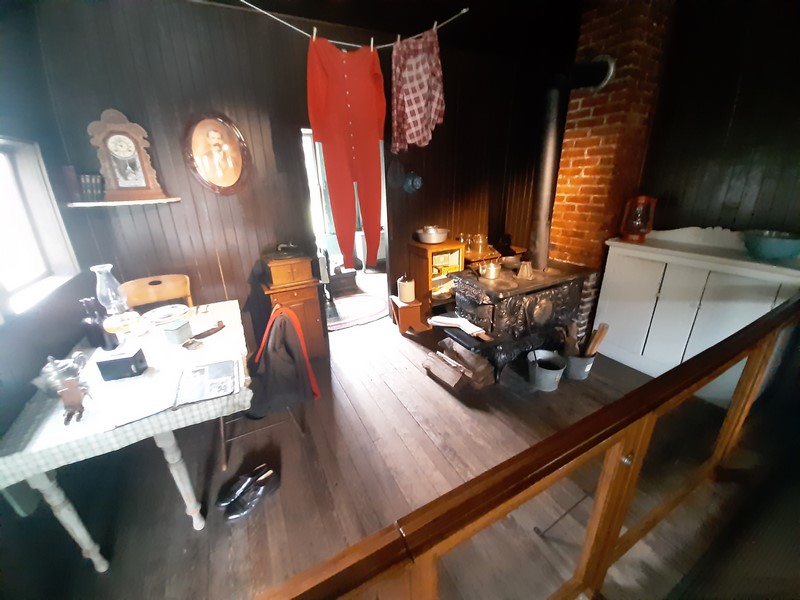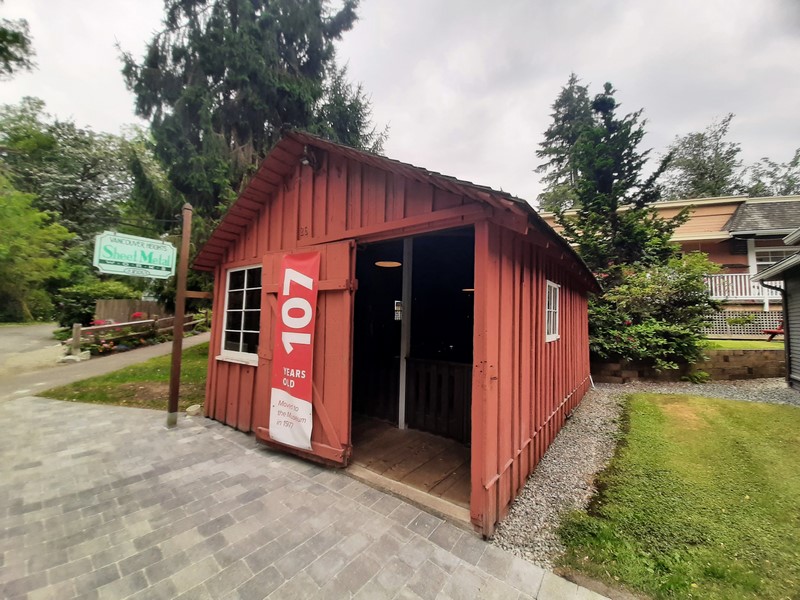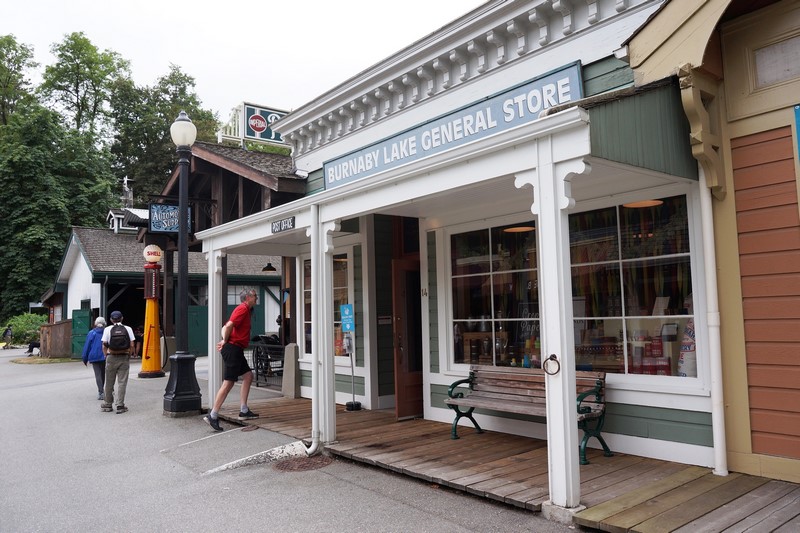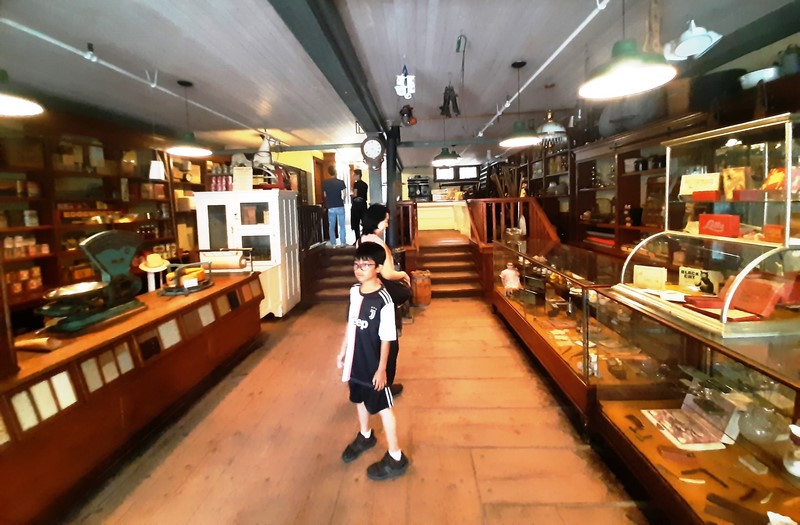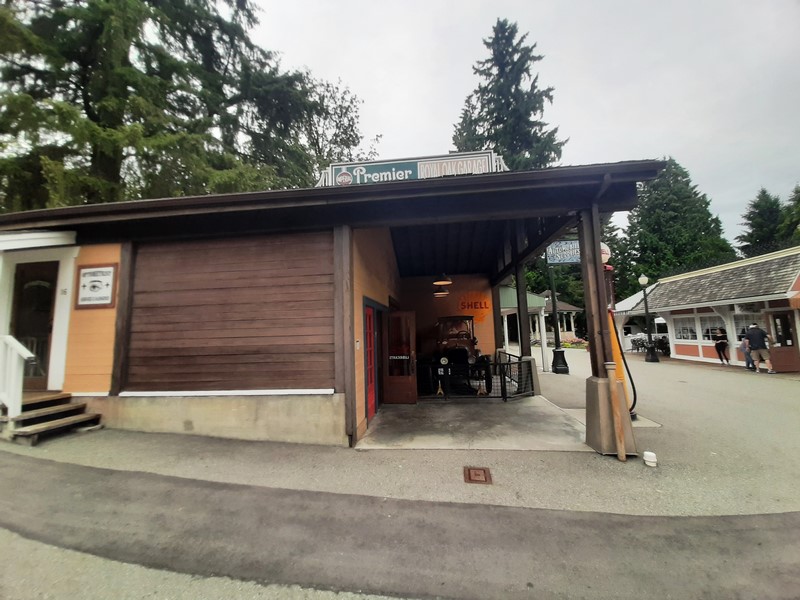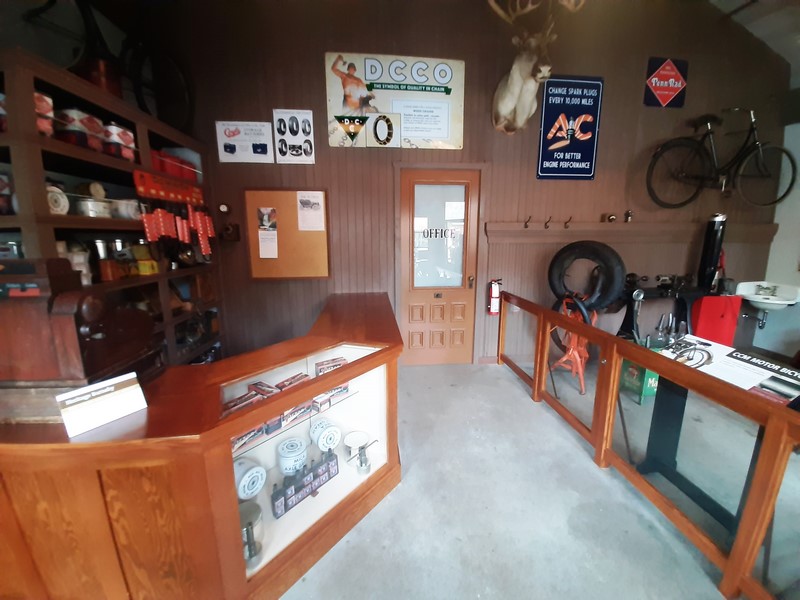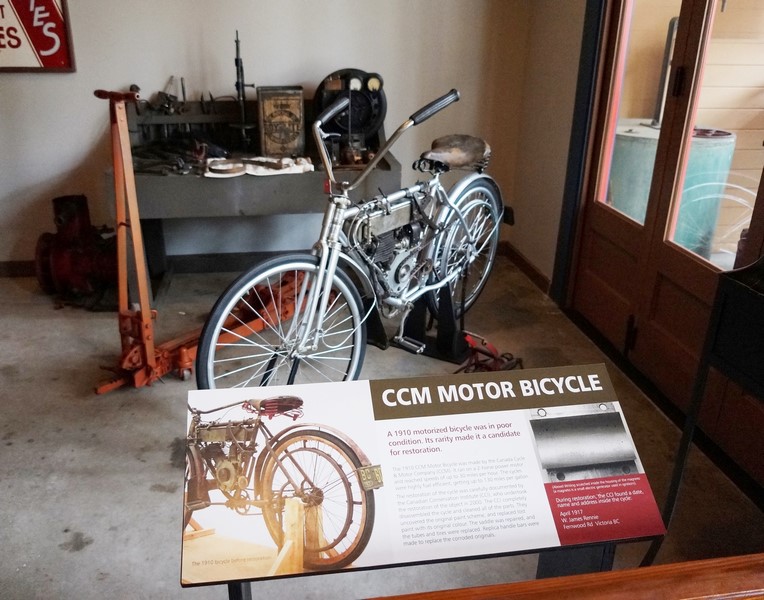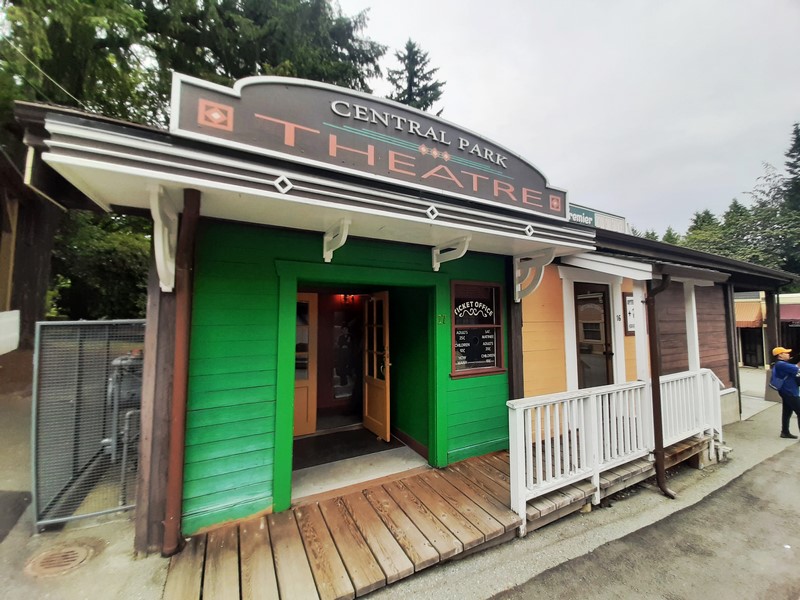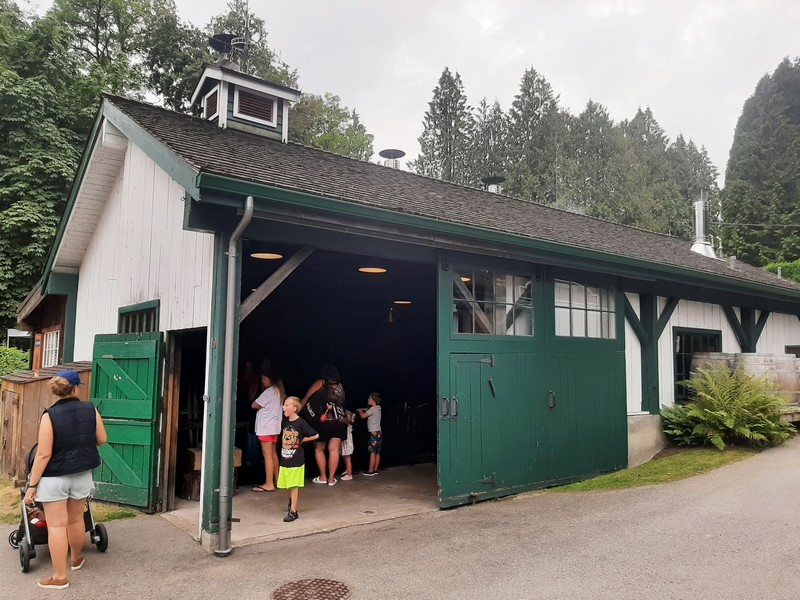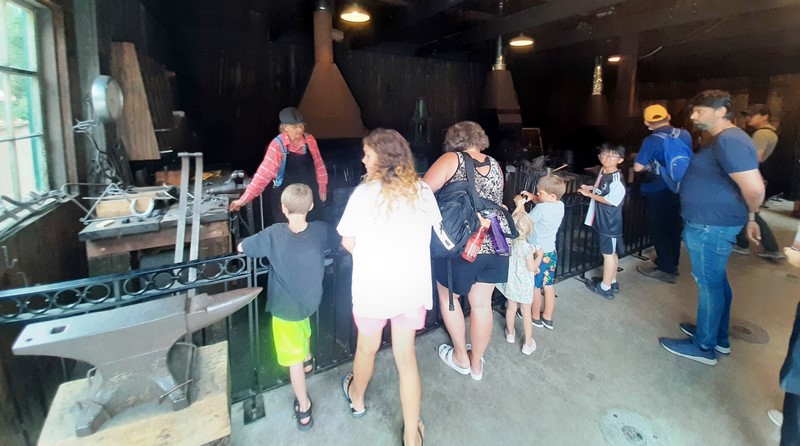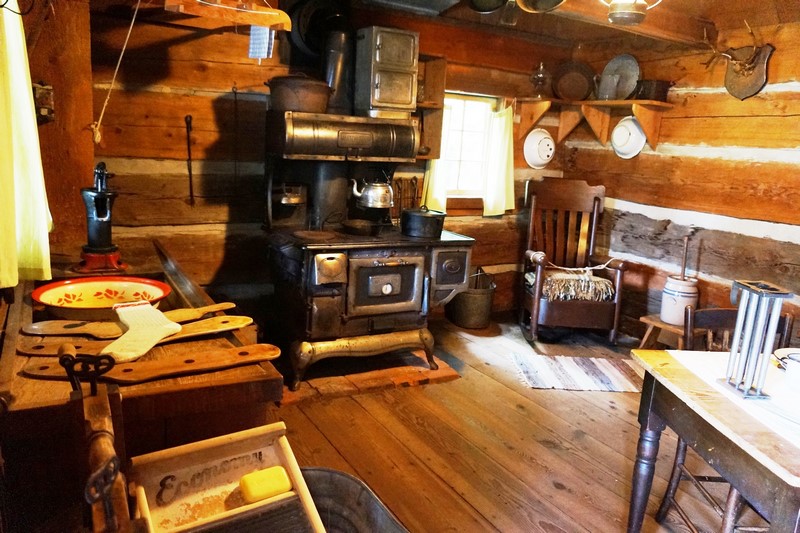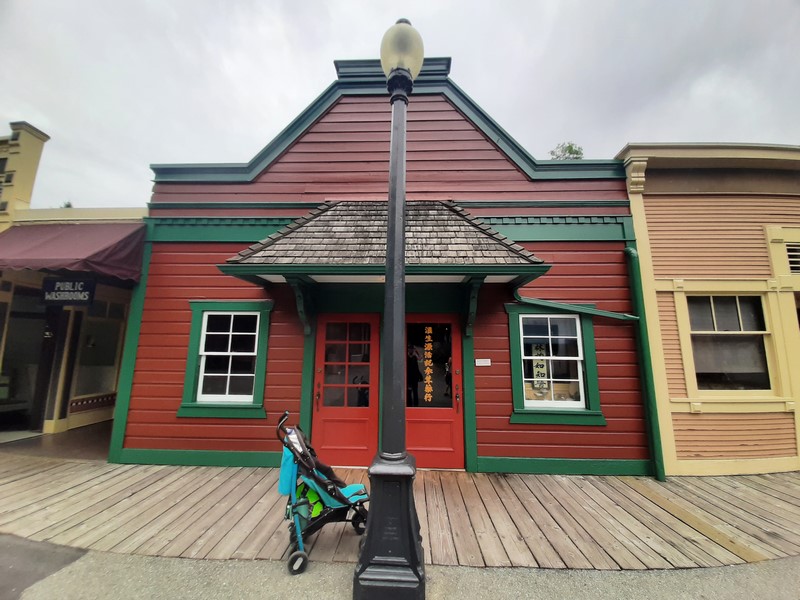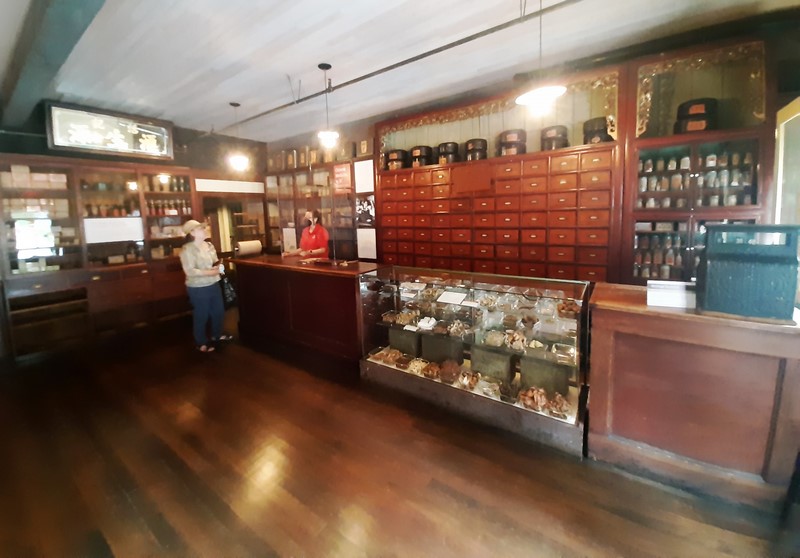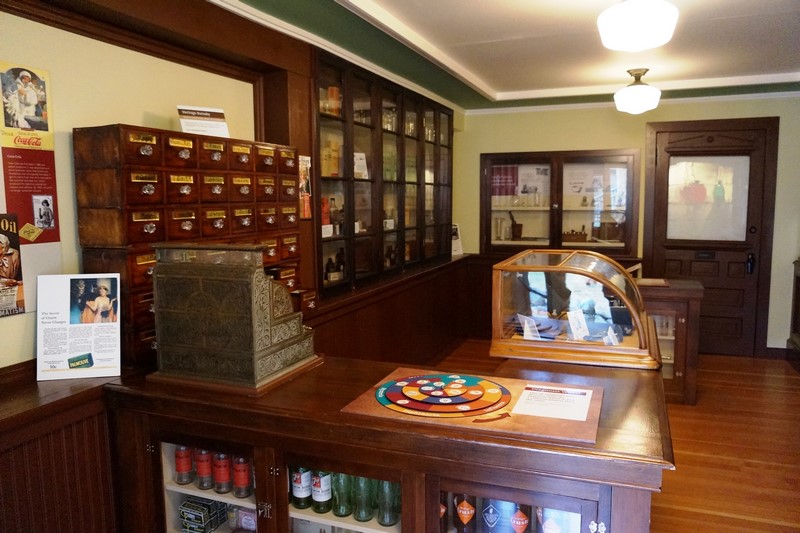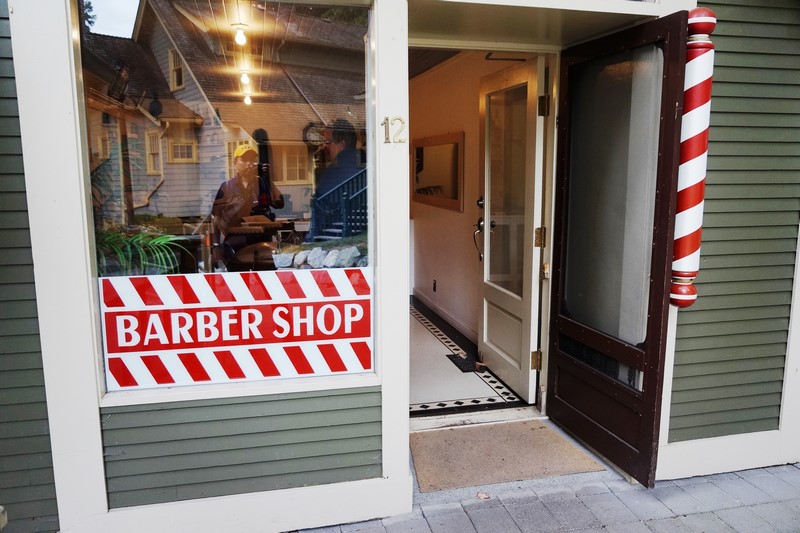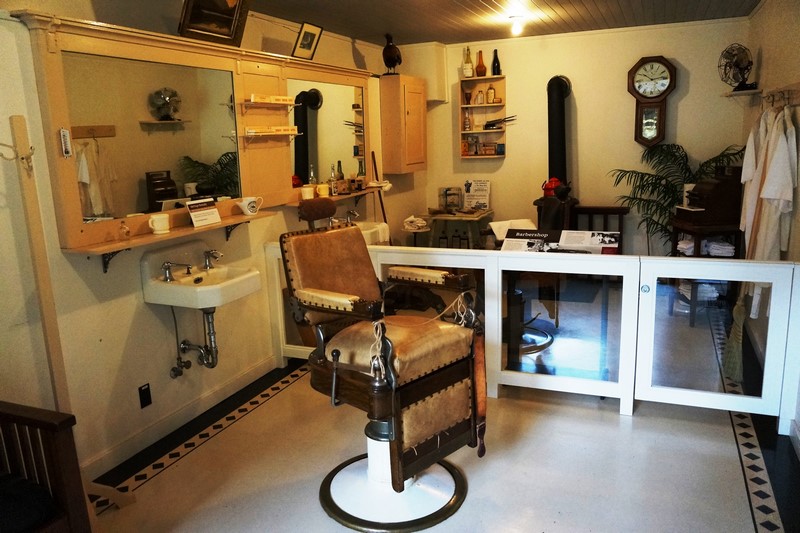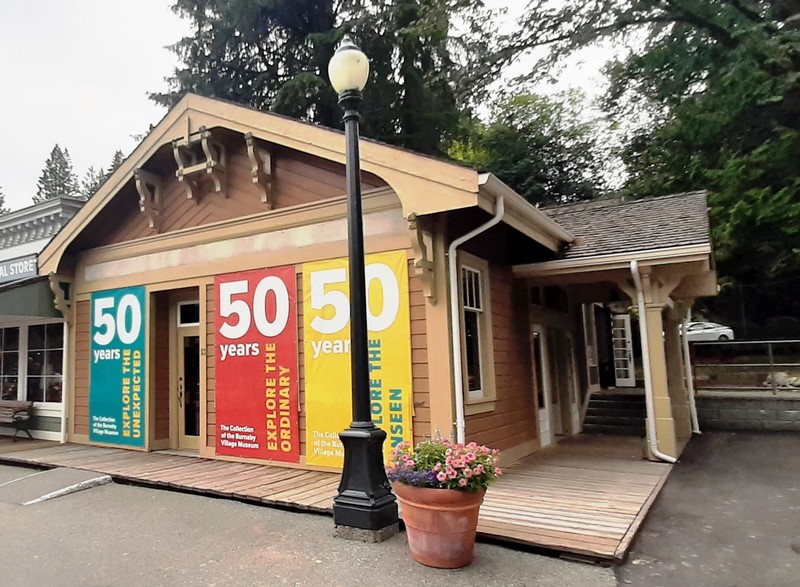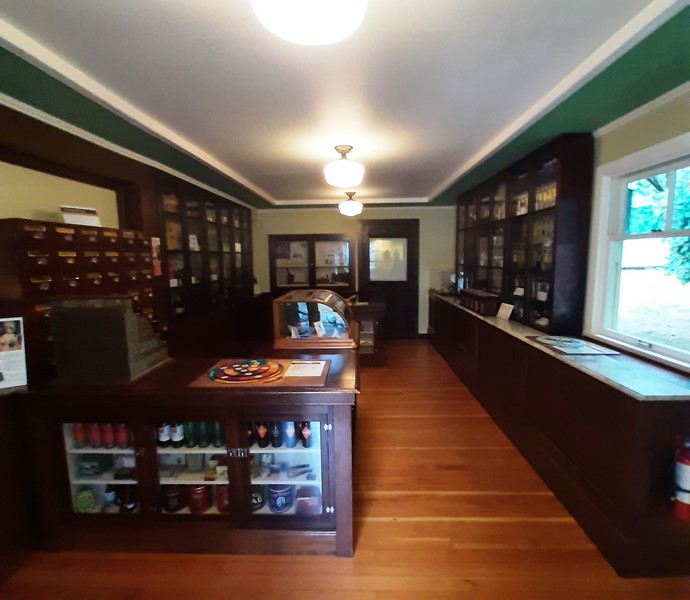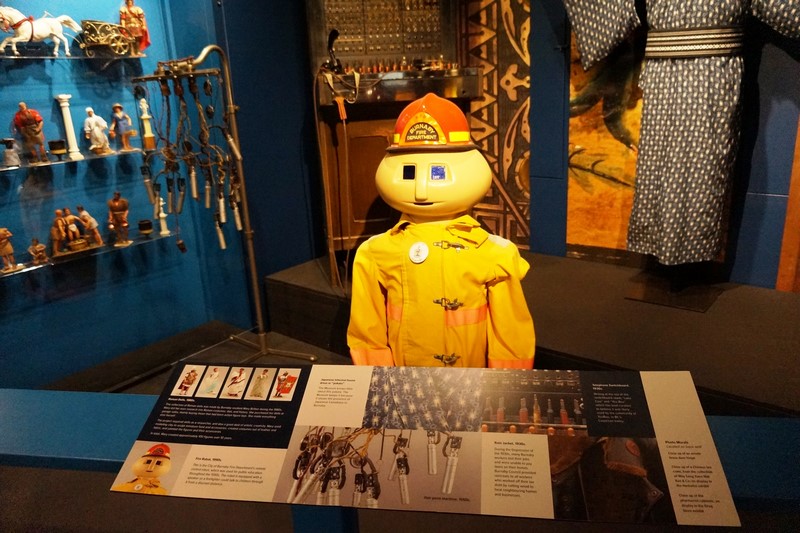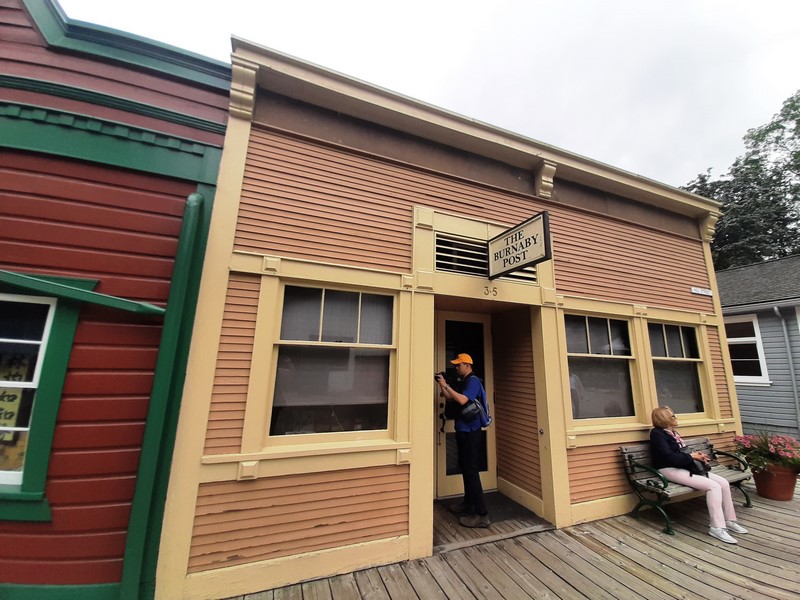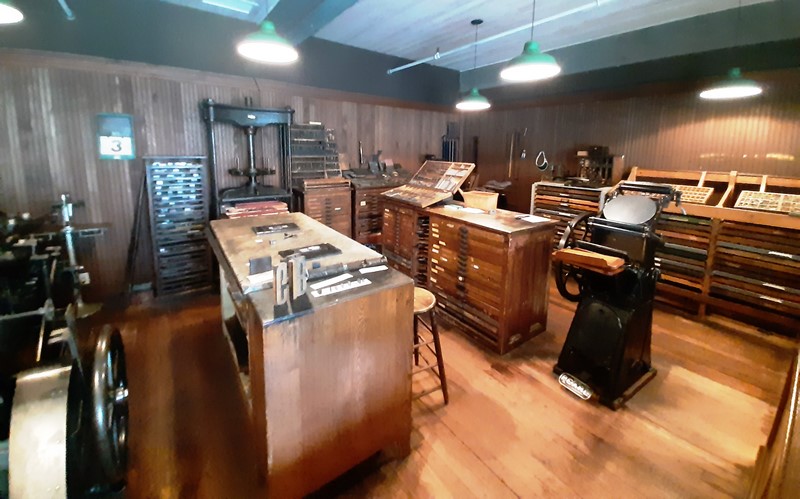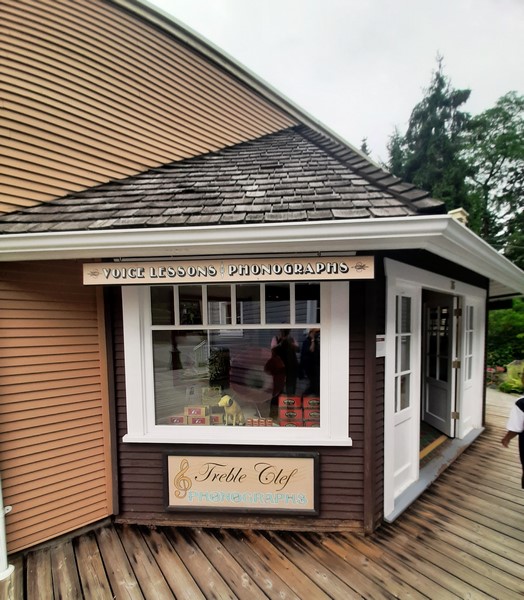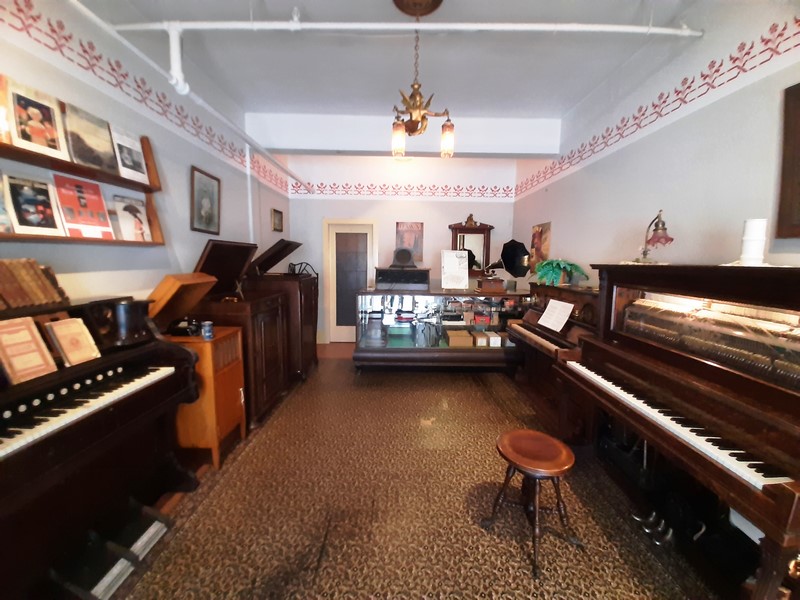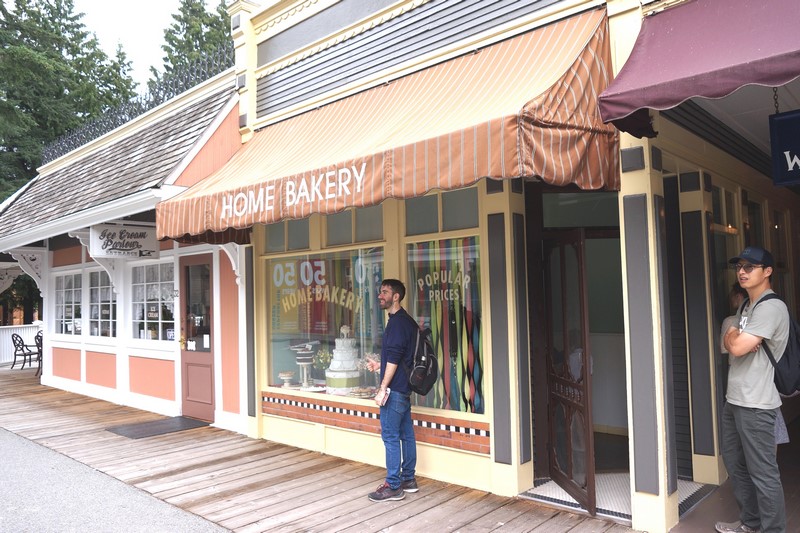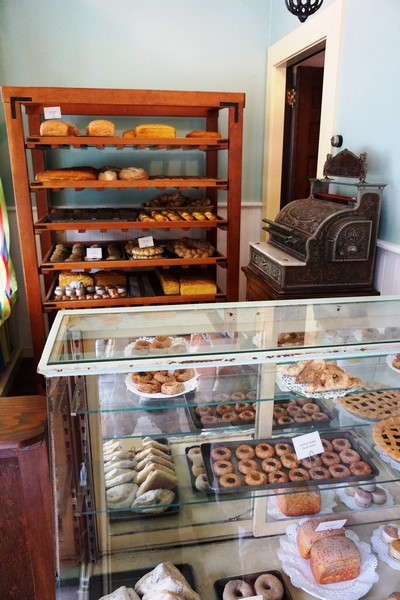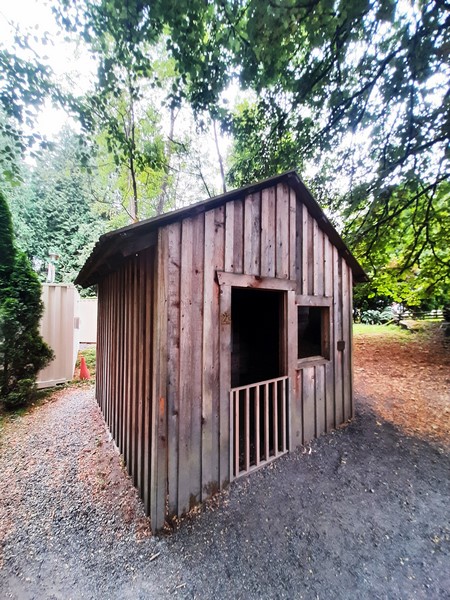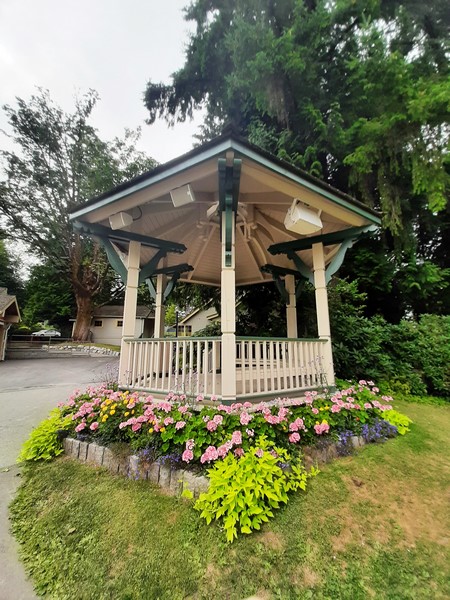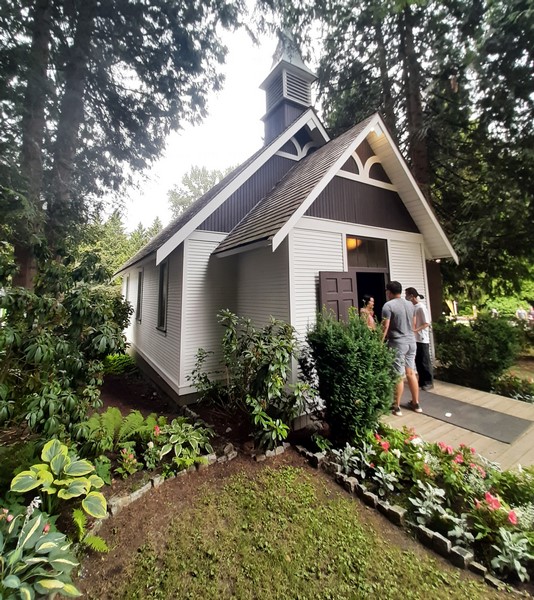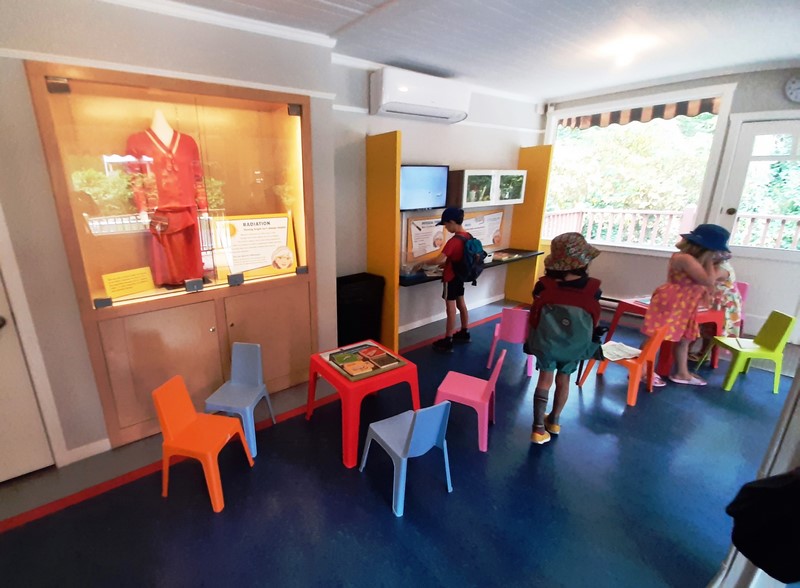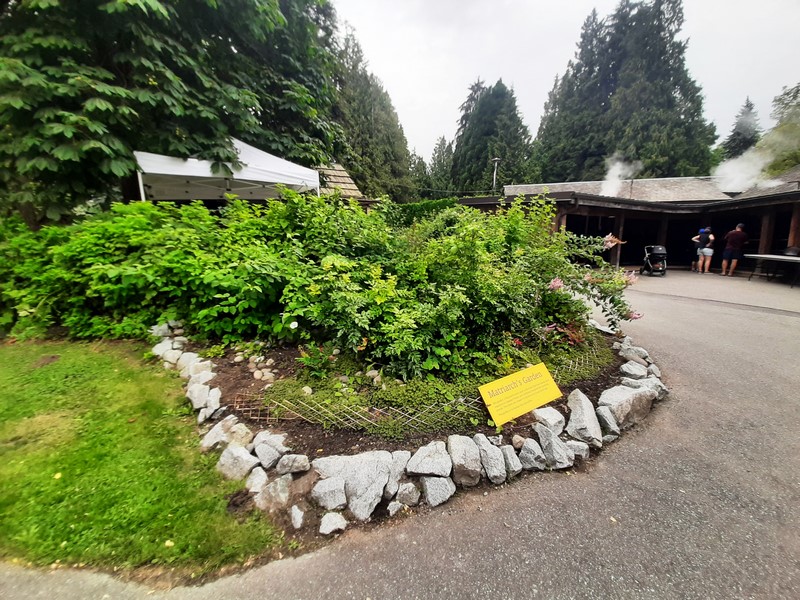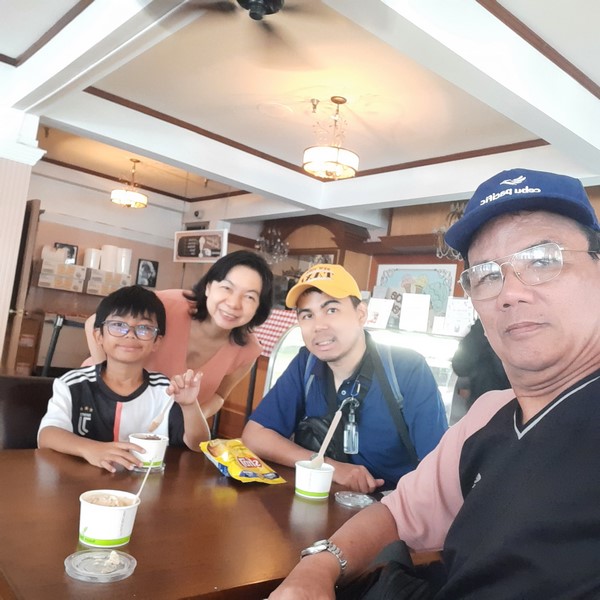On our 23rd day in Canada, right after lunch, Grace, Jandy, Kyle and I opted to visit the Burnaby Village Museum, an open-air museum located at Deer Lake Park. From Holdom Station, we took the SkyTrain to Sperling-Burnaby Lake Station then rode Bus 144 to the museum.
Our visit was timely as the museum only opens seasonally, from May to September, and opens for special events taking place from September to March. Upon entering, we crossed a wooden bridge, with signs talking about Deer Lake Brook and, once across, the trees opened to the reconstructed 1920s village, the most noteworthy part of the museum.
Previously known as the Heritage Village the museum has grown from 1.7 hectares (4.3 acres) site, with a small number of displays, to a 4 hectare (10 acre) heritage site and major attraction in Metro Vancouver. The Museum is affiliated with the BC Museums Association, Canadian Museums Association, and the Canadian Heritage Information Network. Burnaby Art Gallery is in the same park.
Coincidentally, our visit coincided with the museum’s 50th anniversary. and near the entrance were life-size Anniversary Arches which showcases the Museum’s evolving role in the community through the eyes of local artists. The first arch had the Filipino greeting Tuloy Po Kayo (“Please Come In”).
Here is the historical timeline of the museum:
- On November 19, 1971, the museum was officially opened (officiated by Roland Michener, then Governor General of Canada). Over 15,000 visitors attended the museum during its special three-day (November 19-21) opening.
- On July 1, 1972, 2 PM, the museum opened for its first full public season. It included several shops located in replica buildings on the main street, and the “manor house” (the 1922 home of the Bateman family, today known as Elworth). Livestock, including horses that were shod in the blacksmith shop, were part of the display. An early promotional brochure promised visitors they would be able to “smell the burning hoof.”
- In 1975, the B.C. Society of Model Engineers opened a model railway at the Village.
- In 1979, the Heritage Village became the set for the Canadian/German co-production of the 26-part TV series Huckleberry Finn and His Friends.
- In 1984, the museum’s name was changed to reflect its role as Burnaby‘s community museum
- In 1985, Iredale Partnership was hired to create an expansion concept for Burnaby’s Municipal Council to consider.
- In 1986, the plan was completed
- In 1987, the plan was accepted by Council. At that time, the site was expanded to approximately 9 acres, with new lands across Deer Lake Brook made available to the Museum to expand, and to create a new entrance facility and administration building.
- In 1989, the miniature railway moved to Confederation Park.
- In 1990, the Municipality of Burnaby took over operation of Burnaby Village Museum from the Century Park Museum Association.
- In 1999, the Museum’s popular “Business as Usual” school program was launched
- In 2000, the “Home Sweet Home” program was launched.
- In 2010, the Burnaby Village Museum was an official stop for the Olympic Torch Relay.
- For the 2011 summer and Christmas seasons, in celebration of the 40th anniversary of the Museum, Burnaby City Council agreed to offer free admission to museum visitors.
The first place we visited was the Don Wrigley Pavilion, a pavilion located at one of the museum’s two entrances (earning the entrance the name “Carousel Entrance”). Here, my grandson Kyle, accompanied by Jandy (Kyle needed to be accompanied by an adult), tried out one of the museum’s major attractions – the C. W. Parker Carousel, a carousel built in 1912 by Charles Wallace Parker (owner of the C. W. Parker Company at Leavenworth, Kansas).
One ride cost $2.65 per person. This would be the second time they would ride a carousel (the first was in Butchart Gardens in Victoria). Setting the tone for the carousel was a Wurlitzer Military Band Organ (Style 146B), built by the Rudolf Wurlitzer Co, ca. 1925, which recreated the sound of a 20-piece military band. The machine was bought from a collector in Spokane, Washington who obtained it from a closed down traveling carnival in Reno, Nevada.
Check out “Butchart Gardens”
The carousel also had a colored history. Also known as the Parker #119 and the Burnaby Centennial Parker Carousel, the carousel, the 119th such machine built by the C. W. Parker Company (earning it its “Parker #119” nickname), contains 41 horses. In 1913, it was sold for $5,886.00 and, for two years, the carousel toured Texas with the Lone Star Circus.
In 1915, the machine was shipped back to the factory where it is believed that the machine was rebuilt and some fancier horses and heavier rounding boards may have been added. Each horse is a work-of-art that was hand-carved and painted. Some of the horses were built in 1917 and some in 1920–1922.
From 1915 to 1936, the history of the carousel is unknown. In 1936, the carousel was purchased by Happyland, an amusement park in Vancouver, British Columbia and remained there until the amusement park was demolished in 1957. The carousel was moved to the new small pavilion in Playland, (another amusement park in Vancouver) until that too was demolished in 1972.
From 1972 to 1989, Parker #119 was operated outdoors, and was put away each winter. In 1989, the PNE’s historic carousel was decommissioned and it was announced that the carousel would be sold off, horse by horse, at an auction in New York but local residents came together to raise the money to purchase and save the carousel, forming the “Friends of the Vancouver Carousel Society.” It was at this time that the carousel was nicknamed the Parker #119.
In May 1989, the Burnaby Village Museum agreed to provide a home for the carousel and the “Friends” led by President Don Wrigley, set about raising the $350,000 to purchase the machine. Keith Jamieson, a carousel expert, was brought in to coordinate the rebuilding project. In 1990, the carousel was purchased and funds were also raised to pay for the restoration.
People who donated money could sponsor a horse and later name it. The museum agreed to build a new pavilion to house the carousel. Named the Don Wrigley Pavilion, the pavilion was completed in 1993 and, that same year, the carousel (now named the Burnaby Centennial Parker Carousel) was officially opened.
Another machine with a colorful history here is the Old Curly Locomotive, the oldest surviving steam locomotive in British Columbia. Built in San Francisco in 1879, this “pony locomotive,” initially named Emory, was a yard locomotive employed in building a seawall in San Francisco. In 1881, it was brought north, just outside of Yale, British Columbia, to work on the construction of part of the Canadian Pacific Railway (CPR). Four wheel tenders, with 600 additional gallons of water, was added.
Following the completion of the railway in 1885, it was barged over to Vancouver Island for use to log most of the timber in Surrey as well as several railway logging operations along the coast by the British Columbia Mills Timber and Trading Company until 1927. Its name may be a reference to Satan although the broadcaster Red Robinson believes it was named after his grandfather Curly Surgenor. After years of neglect, it was restored by the CPR in the 1930s and placed on display at Hastings Park (PNE) in Vancouver. In 1973, it was moved to the Burnaby Village Museum.
Along a shaded arterial pathway, we passed by the War Memorial Fountain, a granite drinking fountain built by local stonemason William Williamson. Erected in 1923 by the Burnaby Civic Employees Union (now CUPE Local 23), it was originally located in front of Burnaby‘s original Municipal Hall at Kingsway and Edmonds Street. An engraved memorial, at the top of the fountain, commemorates Burnaby’s municipal employees who lost their lives in World War I. At the bottom of the memorial is a stone drinking bowl for dogs. In 1974, the memorial was moved to the museum.
At a meadow is the Vorce Tram Station and the Interurban Tram Barn. The Interurban 1223 Tram Barn houses a restored 1912 British Columbia Electric Railway interurban tram, complete with information about the history of the BCER and its role in the development of Burnaby.
In 2001, the 1912 interurban tram was moved offsite to a warehouse, where it would undergo a 5-year restoration project by the Friends of Interurban 1223. In 2007, the restored Interurban 1223 was returned to the Museum, and installed in the newly constructed tram barn.
The barn also houses displays, posters, and photos, with knowledgeable staff members providing operational details to visitors (did you know that trams of the era had a unique feature? Their seats can be reversed, allowing passengers to always face forward.
The Vorce Tram Station, a modest utilitarian passenger tram shelter, was originally built in 1911 at the foot of Nursery Street as part of the British Columbia Electric Railway Company’s (BCER) Burnaby Lake Interurban Line. In 1953, it was moved to a local farm by the Lubbock family and, in 1977, was acquired by the Burnaby Village Museum and installed adjacent to the tram barn. In 2008, under the auspices of the City of Burnaby Community Heritage Commission, it was restored to its original appearance.
Designed and built by the BCER, it is typical of the small local passenger stations on the Burnaby Lake and Chilliwack interurban lines. The wood frame structure, with is rectangular plan and hipped roof, is enclosed on three sides, with an open side for access to the train platform and a single long built in bench across the back of the station. Named after C.B. Vorce (the Chief Engineer for the company), it is the last remaining interurban station in Burnaby and one of the few extant structures left in the Greater Vancouver region that were once part of the extensive British Columbia Electric Railway (BCER) interurban system.
Next, we visited the one and one half storey, wood frame Elworth, the “manor house” designed by English born and trained architect Enoch Evans (1862-1939) of E. Evans and Son and built in 1922 by contractor William Dodson for retired Canadian Pacific Railway executive Edwin Wettenhall Bateman (1859-1957) and his wife, Mary (Dale) Bateman (1865-1935).
The adjacent Elworth Garage is the original garage of the Elworth home. Both are the only historic buildings standing on their original site within the grounds of the Burnaby Village Museum.
This beautiful home, once part of the exclusive Deer Lake neighborhood, was named after Edwin Bateman’s birthplace in Cheshire, North West England. and is a typical example of the eclectic Period Revival influences that were common to domestic architecture in the post-World War I era.
It has an imposing, full open front veranda supported by exaggerated Ionic columns, cedar shingle sidings, two flanking brick chimneys, and multi-paned, double hung wooden sash windows.
In 1970, Elworth was purchased by Burnaby and became the focal point for the development of the museum.
Both the interior and exterior of the house have been restored and interpreted to the date of original construction, including recreated room interiors and period furnishings.
As we moved further along the Village, we felt we entered a movie set. In fact, a number of movies and TV series have been filmed here including Lucifer, Huckleberry Finn and Friends, Supernatural and Christmas in Evergreen, a Hallmark movie. The grounds of Burnaby Village Museum (BVM) has four streets – Finlayson Avenue, Hill Street, Brookfield Lane and Bate Avenue. Annually, more than 150,000 people visit the museum to experience the area’s insightful past.
Burnaby Village Museum contains 31 full scale buildings, some of them original heritage buildings, moved from other locations in the community and restored. They have designated working antiques and there are a total of 50,000 artifacts throughout the various buildings. Each building offers a little bit of history about how it contributed to the development of Burnaby.
The Dow, Fraser & Co. Real Estate Office, a 1927 heritage building, was originally a grocery store annex along MacKay Avenue. In 1976, it was set up as a real estate and surveyor’s office.
The Royal Bank Building, constructed in Britannia Beach in 1950, was moved to the village in 1976 and set up to look like Burnaby’s Royal Bank which opened in 1921. Its interior fixtures are from Nelson, British Columbia.
The original Bell’s Dry Goods Store Building, a typical commercial false front, single storey, wood frame building, was built in 1922 by Clifford Tuckey with a small lean-to structure on the back housing a kitchen and bedroom.
Soon afterwards, the store was sold to William and Flora Bell, who then lived and worked their dry-goods business here for a number of years until 1937. Later, the building was sold to Maurice and Mildred Whitechurch, who ran it for many years as a hardware store.
In 1974, the structure was relocated to its present site at the museum. Between 1993 and 1996, the building was restored to its 1925 appearance.
Originally located along Sixth Street in East Burnaby, in a small commercial district that served residents located along the streetcar line between New Westminster and Edmonds, it is one of the last remaining intact false front retail structures of its time to survive in Burnaby as well as one of East Burnaby’s few surviving early commercial buildings.
Representative of other typical commercial structures of the period, this store also served as the location of the East Burnaby Post Office, one of a number of local post offices located throughout the municipality during the early twentieth century.
The Farmhouse of Jesse and Martha Love, the oldest building in the village, was built by Jesse Love and his wife Martha who arrived in Burnaby in 1893 and, over the years, had 11 children.
In 1988, it was moved to the Museum to be part of the “rural zone” display established in the newly acquired museum space across Deer Lake Brook.
Decorated in a 1925 Victorian style, it has a wraparound verandah and has all the modern conveniences – from hot-running water to a radio. Guided tours are available.
The restored Seaforth School Building was originally located on the north side of Burnaby Lake, at 7881 Government Street cor. Piper Avenue. The one room school, designed by architects Bowman and Cullerne and constructed by local contractor Alphonse J. Toebaert, was opened in the rural Lozells District of Burnaby in 1922 with 20 students. By 1989, the popular “3R’s” school program was being offered on a regular basis at the schoolhouse.
In 1983, the historic building was moved, from its original location at Government Road to the Burnaby Village Museum and, in April 1987, the school was opened to the public as part of the Museum’s permanent exhibition.
The Tom Irvine’s House, a small, two-room (living room/kitchen and a bedroom), wood frame bachelor’s house, was built in 1911 by Irish-born Burnaby resident Tom Irvine (a prospector in the Yukon and, later, a pile driver working with the British Columbia Electric Railway Burnaby Lake Interurban Line) and his friend Robert “Bob” Moore.
Bob Moore died soon afterwards but Tom lived in the house until 1958. In 1929, running water was added and electricity in the 1950s. Tom never married and died in 1964, aged 100. Originally located along Laurel Street in Central Burnaby (now the site of the Burnaby Lake Sports Complex), just west of Burnaby Lake and the tram line, it was moved to the site in 1975 and restored to its 1920s appearance.
The little Vancouver Heights Sheet Metal Works Building was once a shed used for horseshoeing on Burnaby’s Lubbock Farm. Today, it houses tinsmithing tools used to make a variety of items out of sheet metal.
Other buildings are replica buildings, created to house specific displays and artifacts.
The Burnaby Lake General Store is a 1920s General Store based on an actual store from Burnaby. On stock were cleaning items, coffee beans, daily grocery items, etc.
The Royal Oak Garage, based on a 1925 garage on Kingsway in Burnaby has, on display, a vintage gas pump, a 1924 Ford Model T and a CCM Motor Bicycle.
Silent movies, from the 1920s, are played in the 20-pax Central Park Theatre.
The Wagner’s Blacksmith Shop is a working blacksmith shop based on a 1925 Burnaby business.
The Log Cabin, built in 1973 (as a North West Mounted Police post to commemorate the 100th anniversary of the RCMP) by Earl Robert Carter using only hand tools, is a reproduction of a log house built in 1860 by William Holmes, Burnaby’s first settler.
Way Sang Yuen Wat Kee, a replica Chinese herbalist’s shop opened in 1975, houses the contents from a store which operated in Victoria from about 1900 to 1971.
The Drugstore has a rotating chart that helps patients identify their disease based on their general symptoms.
There’s also a shining globe, in front of the store, made up of different colors that showed how seasoned the chemist was.
Beside it was the McKay Barbershop, a 1920s barbershop modeled after Burnaby’s McKay barbershop that operated on Kingsway.
The Stride Studios, a temporary exhibit gallery on Hill Street, was opened in 2000. Each year, it features a different special exhibit that explored topics beyond Burnaby in the 1920s to be featured as part of the visitor experience.
In 2011, the gallery hosted “Prints from CPR Magic Lantern Slides, 1885-1930,” curated by Michael Lawlor and Bill Jeffries and circulated by the Simon Fraser University Gallery.
Ongoing, during our visit, was the “We Are 50: Expect the Unexpected – The Collection of the Burnaby Village Museum.” It showcases objects rarely seen by the public before
The Burnaby Post, a working print shop representing the offices of Burnaby’s weekly paper, the Burnaby Post, demonstrates how an early printing press operates.
Treble Clef Phonographs is a 1920s music shop with an operating player piano.
The Home Bakery is a replica of the original “Home Bakery” which was located on Kingsway, just east of Boundary Road.
There’s also a replica of an ofuru (Japanese bathhouse), built in 1977 in partnership with the Japanese-Canadian Citizens Association, to commemorate the arrival in B.C. of the first Japanese immigrant in 1877.
The Museum’s bandstand is based on the Central Park bandstand, built in 1895 and used until the 1920s.
The nearby replica 1920s church, opened in 1974, is used for small weddings, memorials or baptisms. It has hardwood floors, an upright piano, traditional stained glass windows and 14 authentic wooden pews.
The Indigenous Learning House, an important addition to the Village, showcases the culture, language and traditions of the Skwxwu7mesh First Nations (Squamish) who lived here before Burnaby was colonized.
Accompanying this house is the Matriarch’s Garden which contains special indigenous Coast Salish plants, some of them endangered, used for weaving, making tea and food for both humans and animals. The stones here are shaped in a Coast Salish eye, representing the grandfathers. Here, indigenous educators share their knowledge about plants.
The Museum’s costumed historic interpreters or staff members, dressed in vintage clothing of the 1920s, have expert knowledge of the era and demonstrated the traditional trades. There are steam equipment that show how steam was once used to power sawmills and industrial equipment.
Steam donkeys were used to move logs in the forest by winching steel ropes. After our long walk exploring each and every building, we stopped for a sweet gelato treat at the iconic, 1920s-style Ice-Cream Parlour, beside the Home Bakery.
Burnaby Village Museum and Carousel: 6501 Deer Lake Ave., Deer Lake Park, Burnaby, British Columbia V5G 3T6, Canada. Tel: (604) 297-4565. Fax: (604) 297-4557. E-mail: bvm@burnaby.ca. Website: www.burnabyvillagemuseum.ca. Coordinates: 49.2391°N 122.9661°W. Admission is free, except for special events like their Spring Break Scavenger Hunt in March and Haunted Village in late October. There is also a small charge for their carousel rides (around $2.50 in normal years).
Burnaby Village Museum opens seasonally. For 2022, it is open, from 11 AM to 4:30 PM, for school Spring Break, from March 14 to 25; and during summer, from Tuesdays to Sundays, between May 7 and September 5 (as well as on statutory holidays like Victoria Day, Canada Day, BC Day and Labour Day). Admission is free. The Haunted Village (also called Eerie Illusions) takes place from October 20 to 30. Admission to the Halloween attraction costs adults around $10 and $5 for children. Heritage Christmas is set to run from November 26, 2022 until January 2, 2023.
How to Get There: by bus: 110, 123, 133, 144, by SkyTrain: EXPO LINE, MILLENNIUM LINE.

